Stavanger region is close to Lysefjord and the Pulpit rock
Paul Edmundson /www.fjordnorway.com
Kurt Hamann - Visitnorway.com
Martin Håndlykken / Visitnorway.com
CH - visitnorway.com

- Map & transport
Epic landscapes, colourful culture and exquisite culinary experiences await you in the Stavanger region.
Here Norway`s fjord country begins and contains some of the country`s most amazing natural sights such as Preikestolen (Pulpit Rock) in Lysefjord.
Stavanger is close to mountains, fjords and the beautiful beaches of Jæren, with the North Sea as its nearest neighbour. Like the rest of the cities and towns close to the Norwegian Fjords , you will find Stavanger close to the mountains, fjords and unique beaches. Stavanger is also neighbour to the North Sea.
When the oil was discovered in 1966, Stavanger became the oil capital of Norway and many inhabitants in the

What to see and do in Stavanger
The city has a rich cultural life, and you can also have an amazing culinary experience here. Stavanger is known for fishing, agriculture and industry, and populate by around 120.000. Stavanger offers a lot of cultural experiences from museums, galleries, and music events to festivals. In 2008 Stavanger was elected cultural city of Europe.
Related to the beautiful surroundings Stavanger offers all kinds of adventures, and one of the highlights from here is a tour to the Pulpit Rock , known worldwide. From here you get a fantastic view of the Norway fjords and the wonderful unique nature. It is also very recommended with a sightseeing cruise on the 42 km long Lysefjord and experiences the power of western Norway’s landscape at its best.
Getting there
Find routes to this destination.
Coordinates
- Lattitude: 58.969976
- Longitude: 5.733107
Top Hiking Destinations
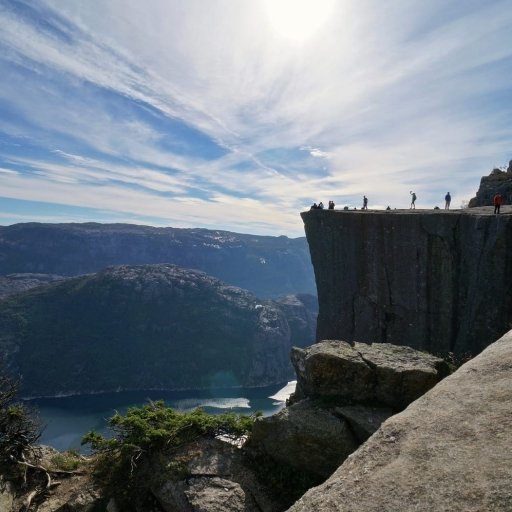
The Pulpit Rock
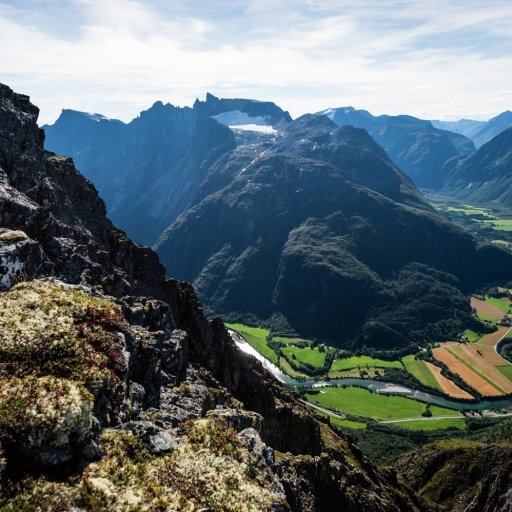
Romsdalseggen
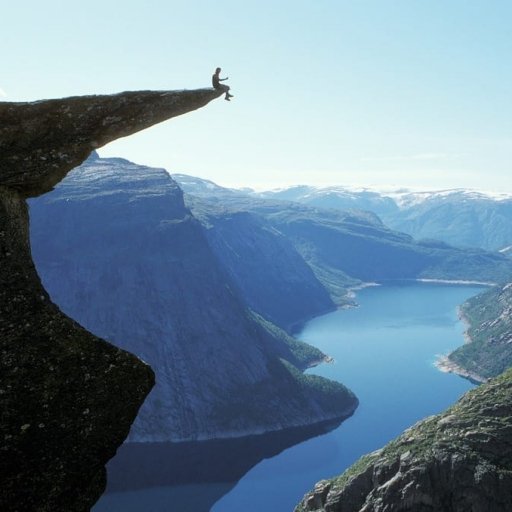
Discover Southern Norway
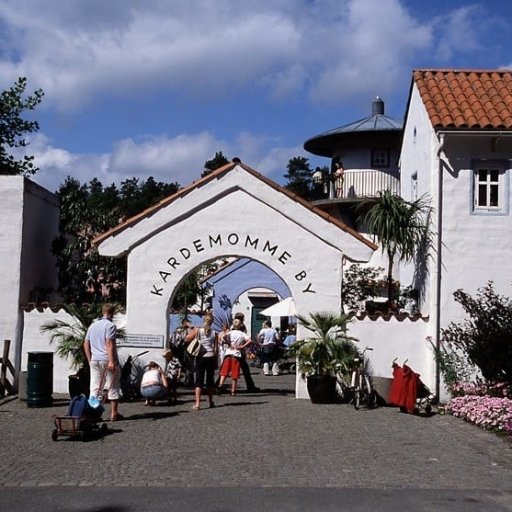
Kristiansand
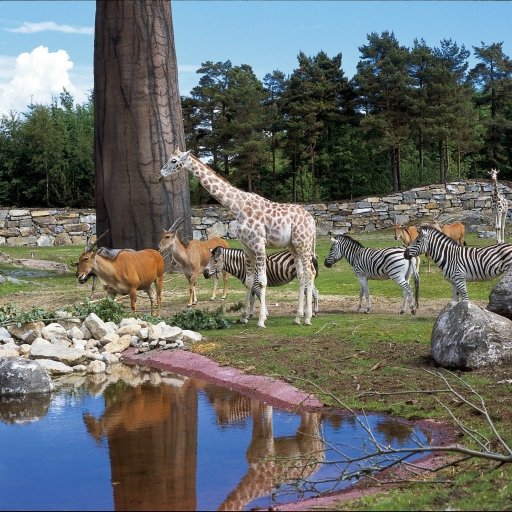
Kristiansand Zoo and Amusement Park
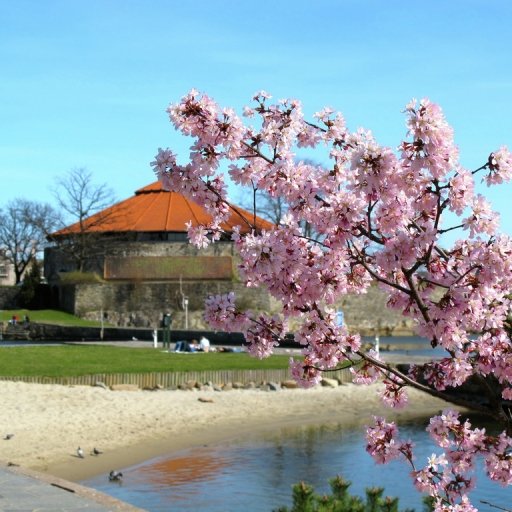
Christiansholm Fortress
Historic roundtrips in norway.
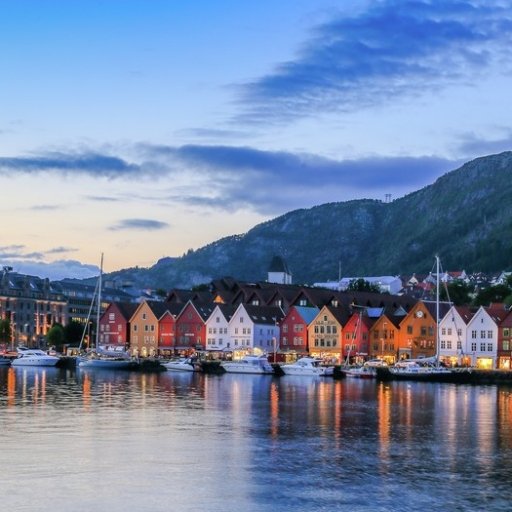
Norway- Historic fjord, city & arctic roundtrip
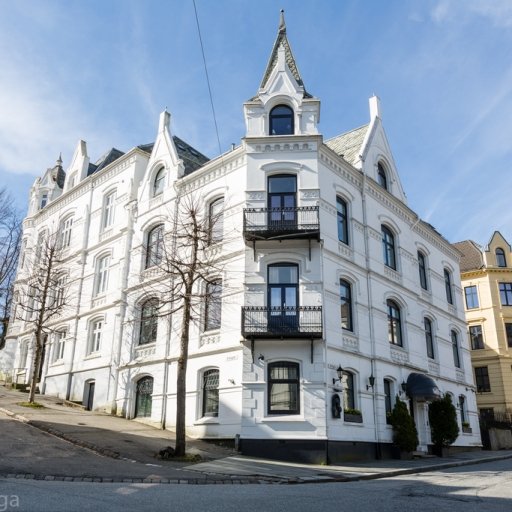
Historical City Break in Bergen

Sparkling Romance in Oslo
Getaways to the norwegian fjords.
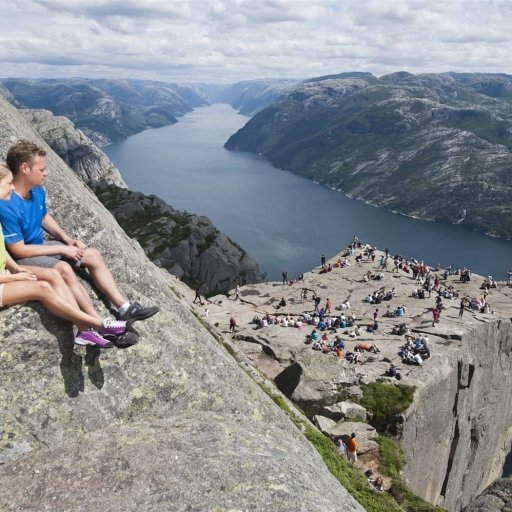
Fjords & Pulpit Rock Cruise
This independent Fjord Cruise tour starts in Bergen and ends in Stavanger. Discover amazing nature and get an excellent feeling about what Fjord Norway is about.

Norway cruises
If you come here, you'll understand why. Dramatic and diverse, Norway's nature ranges from serene forest-covered hills in the southeast and spectacular fjords and glaciers in the west to Arctic wilderness in the north.

The Lysefjord
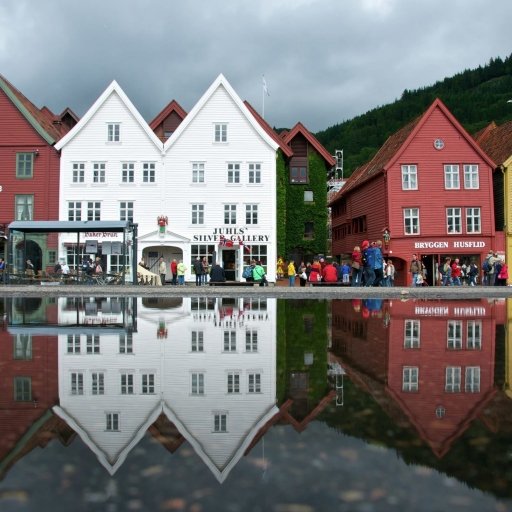
- Nordic Countries
- Inspiration
- Heritage & Culture
- Nature & Activities
- Design & Shopping
- Nordic Vikings
- Seasons & Weather
- Visitnordic
- Privacy Policy
- Terms of Use
- Become a Partner


15 Top-Rated Tourist Attractions in Stavanger
Written by Bryan Dearsley Updated Dec 24, 2023 We may earn a commission from affiliate links ( )
Author Bryan Dearsley has traveled Norway extensively since discovering previously unknown family ties there.
Situated on the southwestern coast of Norway and only a five-hour drive south of the beautiful city of Bergen , bustling Stavanger is the country's third-largest city. It's also one of the oldest communities in Norway, tracing its roots as far back as the 12th century. Well sheltered by offshore islands, it's been a commercial center for centuries and is a popular cruise port today.
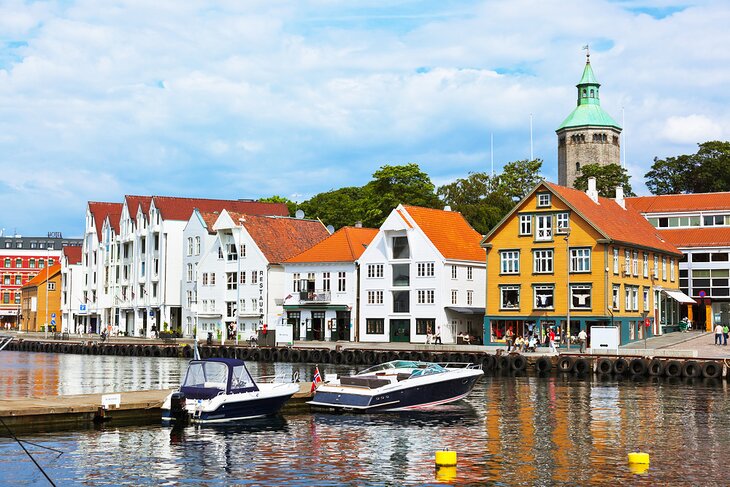
The city is also a vibrant cultural hub, with music venues and annual events that include the MaiJazz Festival each May and the International Chamber Music Festival in August.
Add to that the city's museums, which cover everything from Vikings to offshore oil, along with sardines, aircraft, and seafaring in between, and there are plenty of interesting places to visit and fun things to do in Stavanger. The entire region is popular as a recreation area, with several nearby lakes and a mild maritime climate.
For more ideas on planning your Norway travel itinerary, be sure to review our comprehensive list of the top sightseeing experiences and tourist attractions in Stavanger, Norway.
See also: Where to Stay in Stavanger
1. Pulpit Rock (Preikestolen)
2. norwegian petroleum museum, 3. norwegian canning museum, 4. stavanger cathedral, 5. the valberg tower (valbergtårnet), 6. stavanger museum, 7. gamle stavanger (old stavanger), 8. stavanger maritime museum, 9. breidablikk museum, 10. lysefjord, 11. ledaal house, 12. museum of archaeology, 13. flyhistorisk museum sola, 14. stavanger art museum, 15. utstein abbey, klosterøy, where to stay in stavanger for sightseeing, map of tourist attractions in stavanger, best time to visit stavanger.
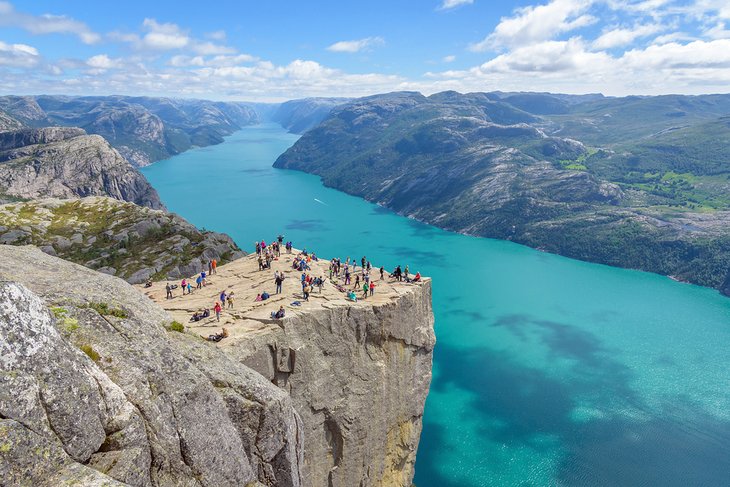
Highlights: A stunning 609-meter cliff with a fantastic view from the top
Pulpit Rock (Preikestolen) is undoubtedly the best-known tourist attraction in the Stavanger area. This massive flat-topped cliff rises nearly 609 meters above the waters of Lysefjord and is one of the country's must-visit bucket list attractions.
It's also one of Norway's most iconic images and has long been the subject of some of the best photography in Norway .
Although Preikestolen is a bit of a trip to reach, it's well worth the effort. The adventure involves a ferry ride, a bus, and a four-hour round-trip hike. But if you have good walking boots (the path can be steep in places) and a head for heights (it's a sheer drop from the edge), the views from here on a clear day are unforgettable.
Location: Rogaland, Norway
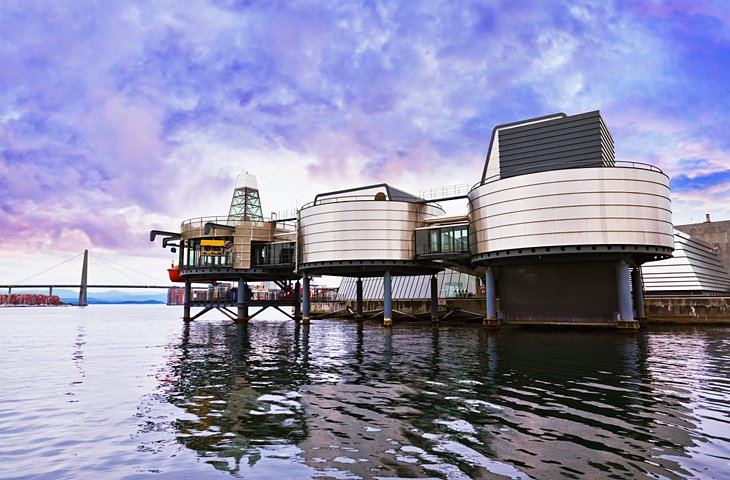
Highlights: Family-friendly interactive displays, educational and fun science center
While the story of oil may not seem a compelling one, this innovative museum makes it relevant, as well as interesting. A lively blend of science, technology, history, environment, and social concerns, the Norwegian Petroleum Museum (Norsk Oljemuseum) sits overlooking the harbor in a building that resembles a series of oil storage drums sitting on an oil rig.
Graphic, audio, and interactive exhibits explore the geology of petroleum and explain why so much lies off the Norwegian Continental Shelf. They explain how these deposits are discovered, how they are recovered, and how they affect the Norwegian economy and society. Even adult visitors will enjoy climbing into a diver's suit, and there are other activities suitable for all ages.
Address: Kjeringholmen 1A, 4006 Stavanger
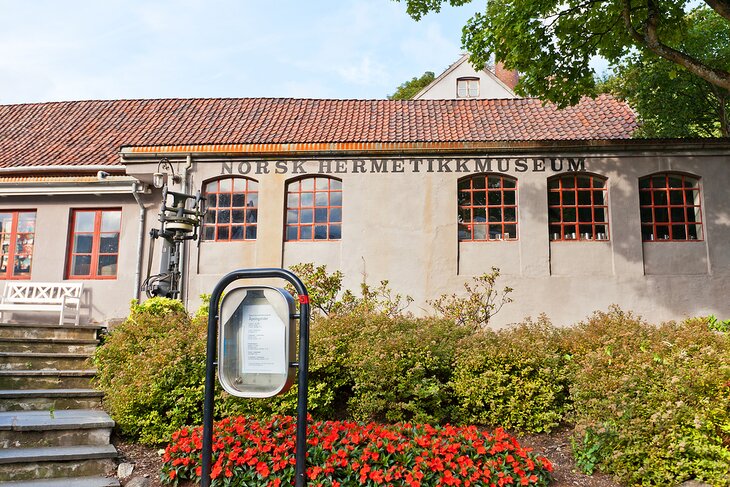
Highlights: Fun dress-ups for kids and hands-on exhibits in a historic building
Who knew sardines could be so interesting? The Venus Packing Co. was one of about 70 canneries in Stavanger and one of 250 in Norway as a whole, and it has been carefully restored to its appearance at the time of World War I.
It's now home to the Norwegian Canning Museum (Norsk Hermetikkmuseum) and is chock-full of interesting exhibits that show how Norwegian sardines were caught and processed from 1879 until the mid-1950s. During this period, these tiny fish were one of Norway's most important export products.
You can see how the fish were processed and follow the improvements in machinery. One of the most interesting exhibits is a single machine manufactured in Germany in the 1930s that packed the cans in greaseproof paper, attached a key, and put the label in place. The collection of labels displayed on the upper floor is a colorful sampling of the more than 40,000 different designs used.
Kids will like the opportunity to dress up as cannery workers and to sample Norwegian waffles in the café, which is in the authentic 1800s workers' cottage. It's been fully restored and furnished to show how it would have looked in the 1920s (on the lower floor) and about 1960 on the second floor.
Address: Øvre Strandgate 88, 4005 Stavanger
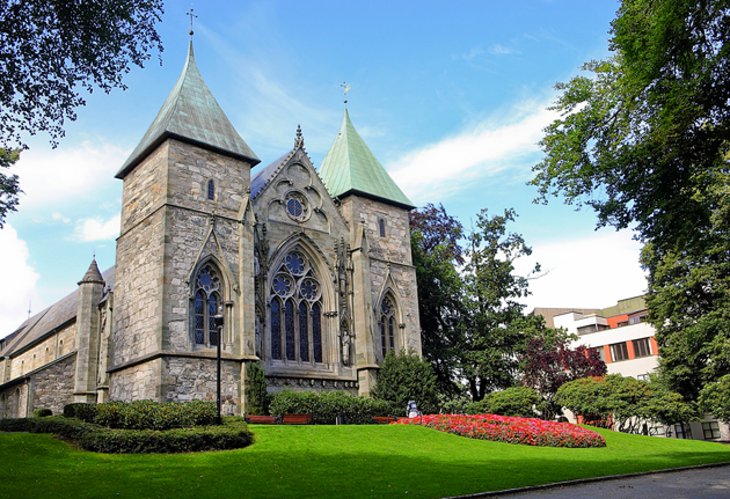
Highlights: Norway's oldest cathedral, close to the historic town square
Located in the city center, Stavanger Cathedral (Stavanger Domkirke) was built in the 12th century by Englishman Reginald of Worcester, later known as Bishop Reinald, as a three-aisle Romanesque basilica. The oldest cathedral in Norway, its choir was rebuilt in Gothic style after a fire in 1272, and the whole church was renovated in the 19th century.
Notable interior features include the richly carved Baroque pulpit (1658) and a stone font of the Gothic period. Also worth checking out is the stained glass in the east window depicting New Testament scenes.
Behind the cathedral sits the former Bishop's Palace, the Kongsgård, overlooking the northern shore of the Breiavatnet — the small lake at the center of the city. The nearby Bispekapellet , or Bishop's Chapel , dates back to the early 1300s and has been carefully restored.
Northwest of Stavanger's cathedral and extending to the harbor inlet (Vågen) is the city's Market Square (Markedsplass). This popular gathering place is a lively spot to spend time shopping at its open-air stalls and soaking up some local culture on nice days.
Address: Domkirkeplassen, 4001 Stavanger
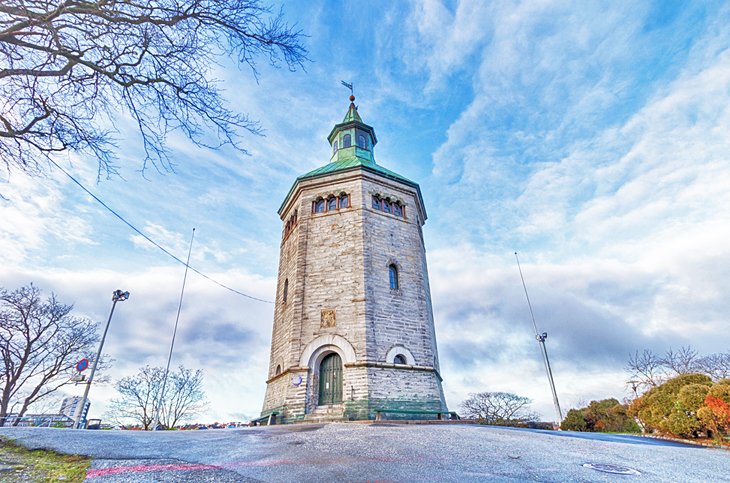
Highlights: Great harbor views from the city's tallest building
Another of Stavanger's well-preserved older buildings, the Valberg Tower (Valbergtårnet) can be found to the north of Market Square between Vågen and Østre Havn (East Harbor). Located in the Holmen peninsula, the oldest part of the town, this former watchtower was built in 1853 on the highest point in the city.
It was the home of the watchman, whose job it was to alert everyone when there was a fire. Today, it is a good place to visit for great views over the harbor and city, as well as the great little Watchman's Museum located on the first floor.
Address: Valberget, 4001 Stavanger
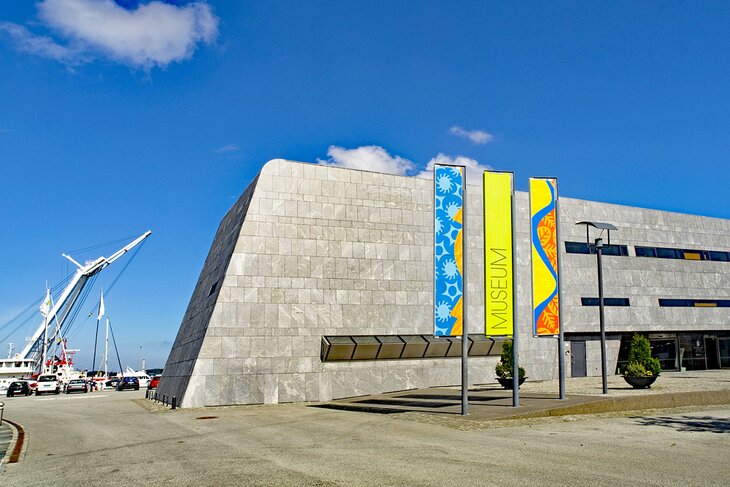
Highlights: Natural history and cultural exhibits, plus a children's museum
The Stavanger Museum is much more than a single museum. The building, in fact, houses exhibitions of natural and cultural history, along with the popular Norwegian Children's Museum (Norsk Barnemuseum).
This fun attraction is a great one-stop shop providing a useful background of the city's cultural roots, its flora, and its fauna. It also tells the fascinating story of how the sea has shaped the community over the centuries, not to mention having somewhere for the kids to learn while having fun.
Much of the museum's collections have been the legacy of generations of Stavanger seamen and missionaries, who traveled to exotic places and brought back art and cultural treasures. These ethnographic collections appear in changing exhibits, as do art, furnishings, costumes, and other pieces of the city's cultural heritage.
Address: Muségt. 16, N-4010 Stavanger
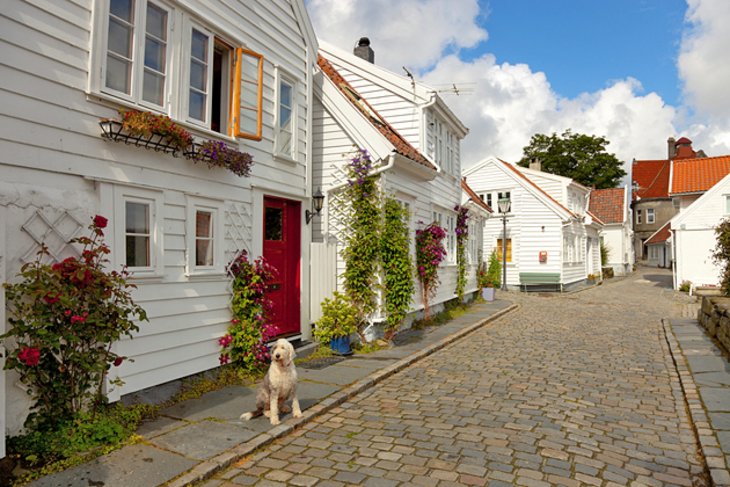
Highlights: Historic quarter with Europe's oldest wooden houses
One of the most picturesque areas of the city is Gamle Stavanger. This historic area consists of a collection of quaint older homes lying along meandering stone-paved streets. This is, in fact, the largest surviving wooden house settlement in northern Europe.
Gamle Stavanger's picturesque streets are well worth exploring, as are its galleries and museums. This area is where you'll find both the Maritime Museum, on Nedre Strandgate, and the Norwegian Fish Canning Museum.
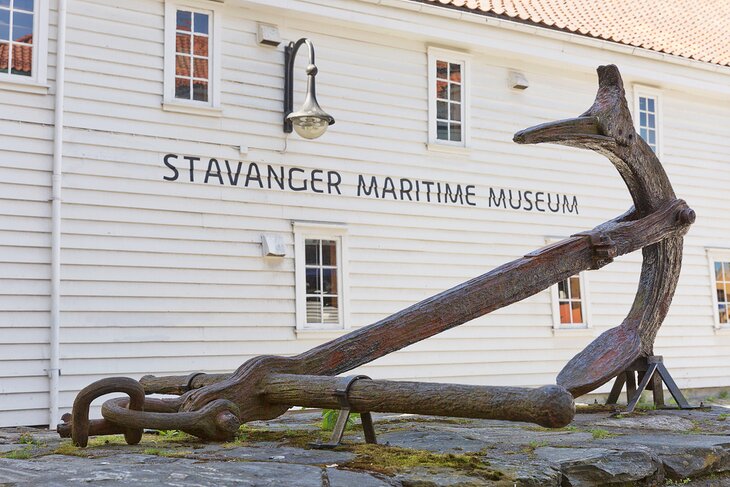
Highlights: Fun for families, costumes and model ships
Stavanger has been a city of seafarers from its earliest days, and the maritime industry has shaped it in many ways, from its early fishing fleets to its modern role as a center for offshore petroleum. You'll learn a great deal about the city's history in the exhibits at the Stavanger Maritime Museum (Stavanger Maritim Museum), which traces the city's business and industry from the herring fisheries and ship-building of the 1800s to today's role as Norway's oil capital.
Beautifully crafted models of working boats and transatlantic liners, actual interiors, and artifacts tell part of the story, while a general store has been re-created from the interiors and merchandise of several dismantled Stavanger shops that served seafarers, fishermen, and other townspeople. A complete and authentic sail loft that operated here until the 1980s has been moved to the museum, complete with all the equipment used by sail-makers.
"Working at the Docks" is an interactive exhibition for children representing a harborside marketplace. Here, they can dress up and play on a fjord boat and at market stalls and harbor businesses.
Address: Strandkaien 22, 4005 Stavanger
Highlights: Elegant historic home with beautiful gardens
The Berentsen family villa, Breidablikk, remains much as it was when the family lived here in the 1880s. Highlights of the Breidablikk Museum today include having the chance to see the original Victorian-era furniture, fabrics, chandeliers, ceramic stoves, knick-knacks, and even flower arrangements, along with a collection of works by foremost Norwegian artists.
Some areas of the house show furnishings of different eras when the house was inhabited: the 1950s library and dining room, even a bomb shelter installed by the family in 1939. Servants' quarters, the laundry room, and the barn with farm tools and carriages are open to view, as are the beautifully landscaped gardens. From here, you can follow the trail to other historic gardens of Ledaal, Holmeegenes, and Munkehagen.
Address: Eiganesveien 40 A, Stavanger 4009
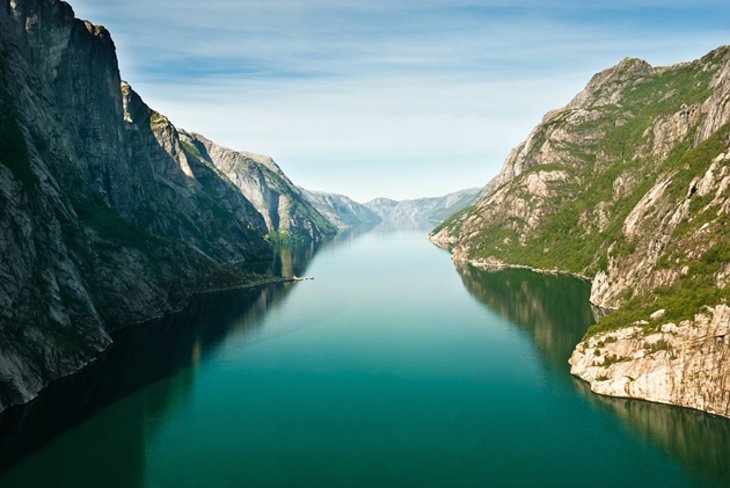
Highlights: Spectacular cliff-lined fjord with incredible scenery
To the east of Stavanger lies Lysefjord, a dramatic cleft in the mountains that's 42 kilometers long and up to 1.75 kilometers wide, revealing stunning bright-green water. Topping it all are the sheer walls of rock rising 1,005 meters above the fjord.
This breathtaking landscape is one of the best sightseeing trips in the area. Fortunately, it's easy to get to, and a number of very pleasant trips by boat can easily be arranged from Stavanger.
One of the most exciting ways to explore this beautiful area is aboard a Lysefjord sightseeing trip from Stavanger with RIB-Safari . You'll be whisked to Lysefjord aboard a speedy RIB tour boat, where you'll have plenty of opportunities to get some great photos from the middle of this impressive body of water. Lifejackets, gloves, and floating suits are provided.
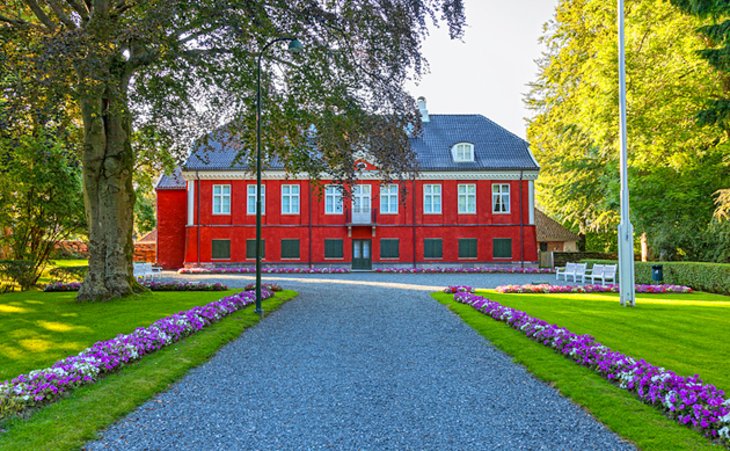
Highlights: Beautiful historic royal home and museum
Built as a summer residence for the Kielland family in 1799, Ledaal House is a perfectly preserved example of how Norway's elite lived in the early 19th century. The richly furnished mansion still functions as a royal residence and is the King's official residence in Stavanger, as well as a museum .
The entire property is owned by the state in trust. Its historic gardens are well worth seeing and are connected to three others via a historic garden trail.
Address: Eiganesveien 45, 4009 Stavanger
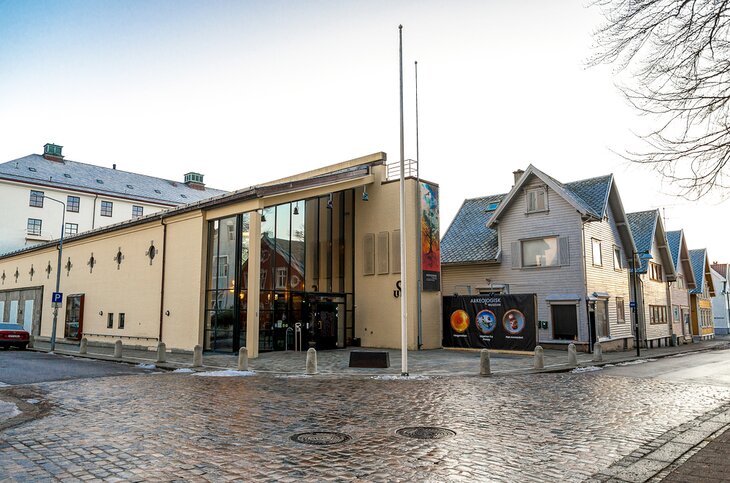
Highlights: Viking history and replica ships
While you're in Norway, you'll certainly want to know more about the Vikings, and the place to do it is at Stavanger's Museum of Archaeology (Arkeologisk museum i Stavanger). The collections include replicas of Viking ships and boats, costumes, historic weapons, tools, and artifacts.
Perhaps the most popular exhibit here, though, has nothing to do with Vikings. The famous Finn, the Finnøy Polar Bear, is a 12,400-year-old skeleton recovered from the village of Judaberg on Finnøy. It is the most complete Ice Age polar bear from its time, and you can learn the fascinating story of Finn's discovery and how he compares to modern-day polar bears.
Address: Peder Klows Gate 30 A, 4010 Stavanger

Highlights: Norwegian air force museum with historic planes
With its focus on aircraft used at the Sola military base and Stavanger Airport, the Flyhistorisk Museum Sola collection includes a variety of completely restored aircraft, as well as aircraft parts from WW2 to the modern day. Its collection of more than 30 historic aircraft includes civilian as well as military planes, plus uniforms, models of aircraft, and historic photographs.
You can actually board some of the planes, a rare experience in an aviation museum, and the signage is in English as well as Norwegian. The museum is at the seaplane port, near Stavanger airport.
Address: Sola Prestegårdsveg 170, 4050 Sola
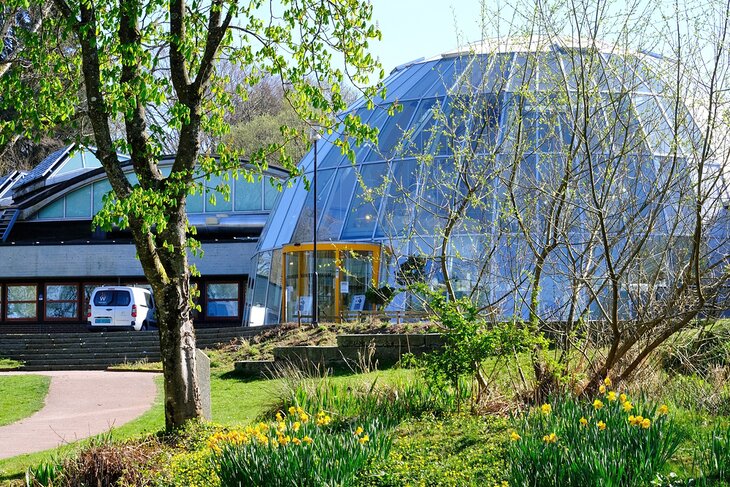
Highlights: Important art collections in a park-like setting
Stavanger Art Museum (Stavanger kunstmuseum), located in a beautiful park surrounding Lake Mosvannet just 3.2 kilometers from the city center, is home to one of the country's finest collections of Norwegian and international art.
Of particular interest is the unique collection of paintings by Lars Hertervig (1830-1902), whose romantic and highly personal landscapes continue to resonate with visitors.
Address: Henrik Ibsensgate 55, 4021 Stavanger
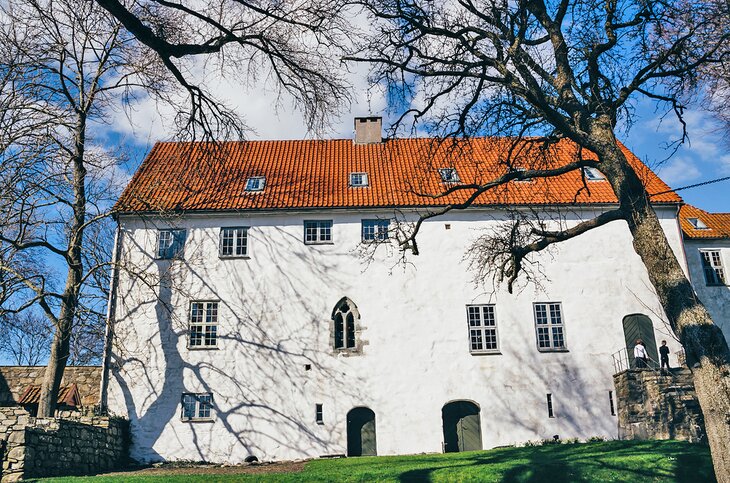
Highlights: Chain of small islands off the coast of Stavanger with historic monastery
To the north of Stavanger are numerous islands and islets, one of the most popular being tiny Klosterøy. Linked to the larger island of Mosterøy by bridge, Klosterøy is famous for its Augustinian abbey, Utstein .
First mentioned in the 13th century, this well-preserved monastic house can be reached from Stavanger by boat.
Address: Mosterøyveien 80, 4156 Mosterøy
If you're visiting Stavanger for the first time, the best place to stay is in the city center. Many of the top attractions are within walking distance of each other here, including Stavanger Cathedral, the old town, and several museums. Here are some highly rated Stavanger hotels in this convenient location:
Luxury Hotels:
- True luxury hotels are rare in Stavanger, but the pet-friendly Clarion Hotel Stavanger , a short stroll from the cathedral and old town, offers comfortable, contemporary rooms, as well as a top-floor Jacuzzi and sauna with city views.
- Located nearby, the Scandic Royale Hotel Stavanger has plush rooms with pillow menus, a spa, a fitness center, and the city's only child-friendly hotel pool.
- A stone's throw from Stavanger train station and handy to the cathedral, the pet-friendly Scandic Stavanger Park , with a fitness center and summer activities for children, is known for its spacious rooms with sitting areas. Breakfast is included in all these hotels.
Mid-Range Hotels:
- In a fabulous location, a five-minute walk from the old town and cathedral, the hip and funky Comfort Hotel Square features bold, in-your-face art, cozy lounge areas, a gym, and a panoramic rooftop terrace.
- Located in a lovely lakeside setting, Thon Hotel Maritim offers sleek, dark-hued rooms and free breakfast, all a two-minute walk from Stavanger Cathedral and the city center.
- A few blocks away, the Frogner House Nygata 24 , set in a red-brick 19th-century building, offers a touch of elegance, with chandeliers and sumptuous fabrics in some of the rooms.
Budget Hotels:
- Budget hotels are also in short supply in Stavanger, but you can walk to town in about 10 minutes from the Stavanger lille Hotel . The hotel's basic rooms have TVs, mini-fridges, and shared or private bathrooms.
The best time to visit Stavanger is in July and August. Near-perfect weather with plenty of sunshine can be expected in the summer months, with cooler yet still pleasant evening temperatures being easily managed with the wearing of a light jacket or sweater.
Spring can also be a nice time to visit. However, it's worth noting that Stavanger's northerly location near the Arctic Circle means spring typically arrives later than other European destinations. It's also shorter, starting in late May or even early June. Although the weather's cooler than you'll experience in the summer, the days are generally long with plenty of sunshine.
Visiting Stavanger in the autumn and winter should be avoided if you're planning on sightseeing. September, October, November, and December are the area's rainiest months, with rainfall expected well over half of each month.
Winter can be a fun time to visit for those who enjoy snow sports. Snow conditions generally last from January into February and March, and although daylight hours are somewhat reduced, you can expect some sunshine to offset the cold temperatures.
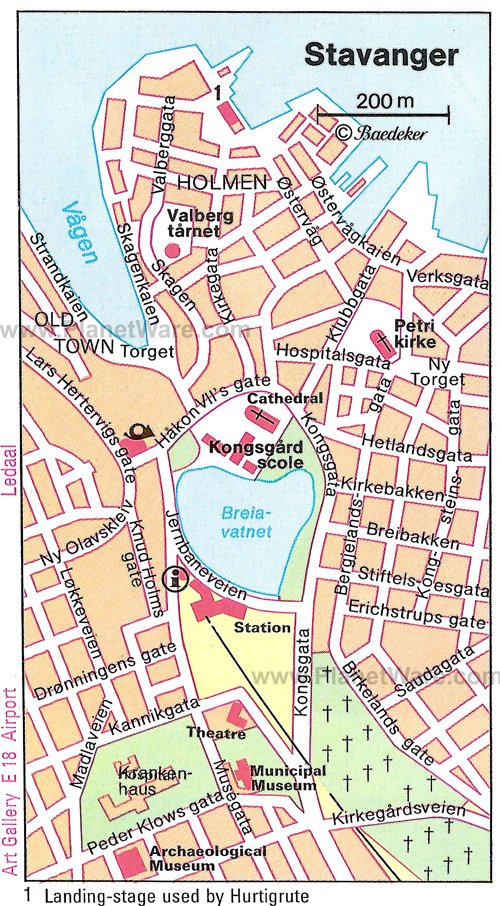
More on Norway
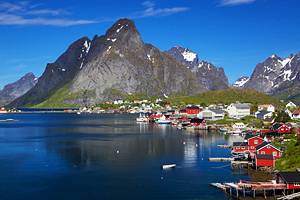

Getty Images
There's a reason this coastal town has been twinned with Houston and Aberdeen: it's sometimes known as Norway's 'Oil City' for its importance in oil exploration in the North Sea since the 1970s (Norway's largest oil company, Statoil, is based here). But while much of the outskirts are modern, you won't find too many skyscrapers – Stavanger's old centre has some of the most beautiful and best-preserved wooden buildings anywhere in Norway, many dating back to the 18th century. It's all very pretty, and in summer the waterfront comes alive in the best port-town style.
Attractions
Must-see attractions.

Norsk Oljemuseum
Admittedly, the prospect of an 'oil museum' doesn't sound like the most promising option for an afternoon out, but this state-of-the-art place exploring…

Canning Museum
Don't miss this surprising museum housed in an old cannery: it's one of Stavanger's most entertaining. Before oil, there were sardines, and Stavanger was…

Gamle Stavanger
Gamle (Old) Stavanger, above the western shore of the harbour, is a delight. The Old Town's cobblestone walkways pass between rows of late-18th-century…

Stavanger Domkirke
This beautiful church is an impressive but understated medieval stone cathedral dating from approximately 1125; it was extensively renovated following a…

Norwegian Children's Museum
Dragging kids round a museum can be a tough proposition, but this is one place that's designed specifically with them in mind. It traces the changing…

Stavanger Museum
Stavanger's main museum was founded in the 19th century, and it's a typically wide-ranging affair, encompassing everything from Stavanger's history to…

Stavanger Kunstmuseum
This museum, 2.5km south of the town centre, displays Norwegian art from the 18th century to the present, including the haunting Gamle Furutrær and other…

Jernaldergarden
Always wanted to experience life on an Iron Age farm c AD 350–550? Then this living exhibition 4km south of town is as close as you'll ever get. Staff in…
in partnership with getyourguide
Book popular activities in Stavanger

Best Things To Do in Stavanger Norway (These 8 Are a Must!)
By Author Jurga
Posted on Last updated: March 11, 2023
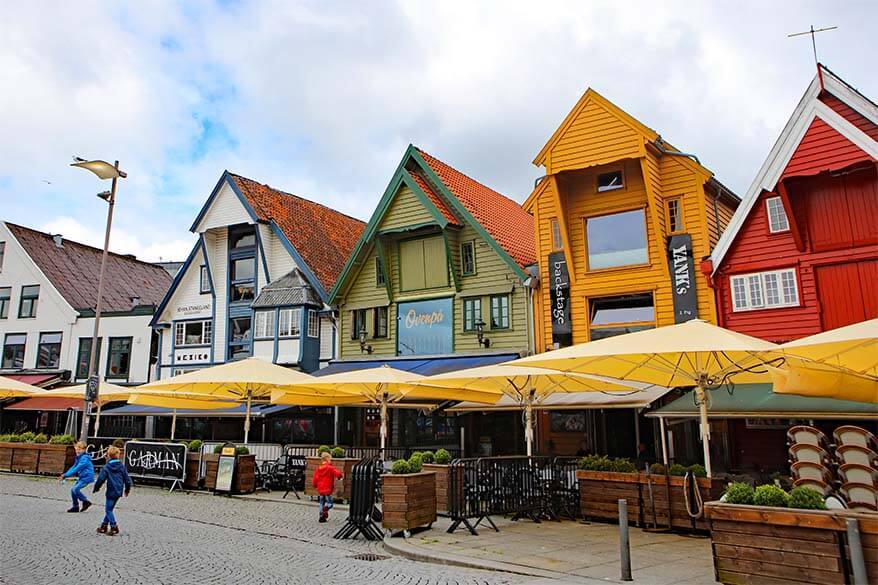
If you are traveling to Stavanger, Norway, for the first time, you are probably wondering what are the must-see attractions in town and what are the best things to do nearby. We spent three unforgettable days here and in this post I am sharing some of the best things to do in Stavanger and best day trips from Stavanger that you really shouldn’t miss.
This is not a complete list of Stavanger attractions. This beautiful region has so much more to offer than that, but if you want to see the main highlights, then look no further. These are the top places to see and things to do in Stavanger.
This list starts with the best things to do in Stavanger town . Further down, you can find the best excursions and day trips from Stavanger . Whether you are visiting Stavanger for a day when cruising Norway or are here for a few days, this article is all you need for your first visit. Find out!
TIP: At the bottom of the post I also included some itinerary ideas on how to spend one, two, three, or four days in Stavanger. You can also find some practical tips and recommendations on the best hotels in Stavanger.

Stavanger was the first stop during our Norwegian road trip and we couldn’t have chosen a better place to fall in love with Norway.
Stavanger really has it all – a beautiful old town with lots of history and cozy atmosphere, quirky museums (that prove that museums can be fun for all), and stunning nature with jaw-dropping landscapes within such an easy reach from town…
Without further ado, here are our absolute favorite things to do in Stavanger :
Gamle Stavanger
Gamle Stavanger (Old Stavanger) is a small historic area with beautifully restored wooden buildings dating from the turn of the 18th-19th century. If you only have a couple of hours in Stavanger, then this is one place you really don’t want to miss.
This protected area was originally home to the workers of the sardine canning industry. More than 170 houses have been beautifully restored and a visit to this historic quarter with its white wooden houses, colorful flowers, and well-kept little gardens is a real treat for the eye.
Strolling through the narrow cobbled streets with the old-fashioned street lanterns and empty benches feels like stepping back in time and you’d almost forget that people live here today… If you want to have an authentic feel of old Norway, then Gamle Stavanger is probably one of the best places to experience this.
Practical information: Gamle Stavanger is located to the West of the old harbor Vagen, just a few minutes walking distance from the Strandkaien cruise ship terminal (see the map ).
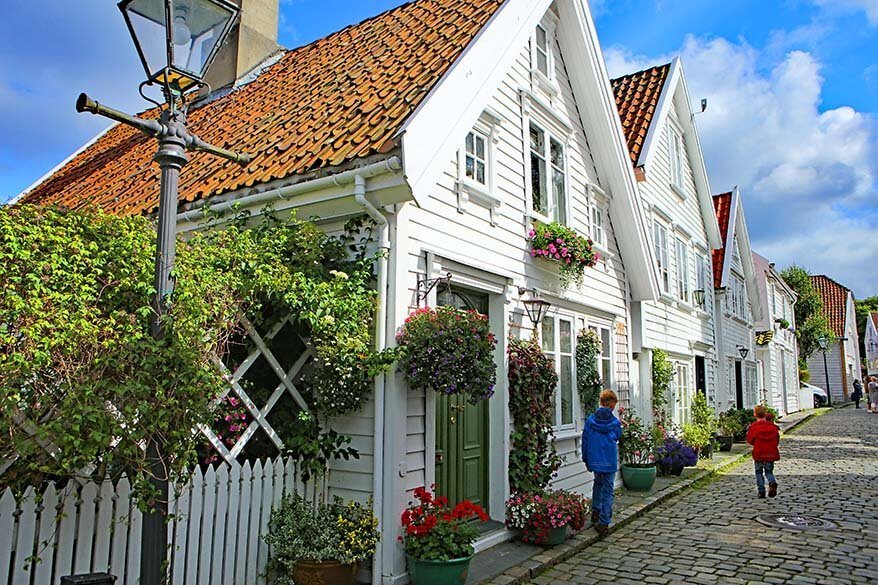
The Norwegian Canning Museum
If you visit just one museum in Stavanger, make it The Norwegian Canning Museum . You’ll never look at a can of fish with the same eyes again!
All kidding aside, visiting this historic museum located in an old canning factory in the earlier mentioned Gamle Stavanger area is the best hour you can spend in Stavanger.
Not only do you get to know the importance of the canning industry, learn how a factory worked, or see thousands of incredibly creative labels that even the best marketing gurus can learn from. On top of that, this museum is really hands-on with lots of fun activities that you can try for yourself. You can thread sardines, lay them in cans, and on certain days you can even taste some smoked sardines… Fun for kids and adults alike!
I really feel that you’d be missing a big deal if you don’t pay a visit to this unique museum when visiting Stavanger. Even if you have just half an hour to spare, take a look inside. You won’t be disappointed.
Practical information: You can find all the practical information on the Norwegian Canning Museum website .
LEARN MORE: What to Expect at the Norwegian Canning Museum
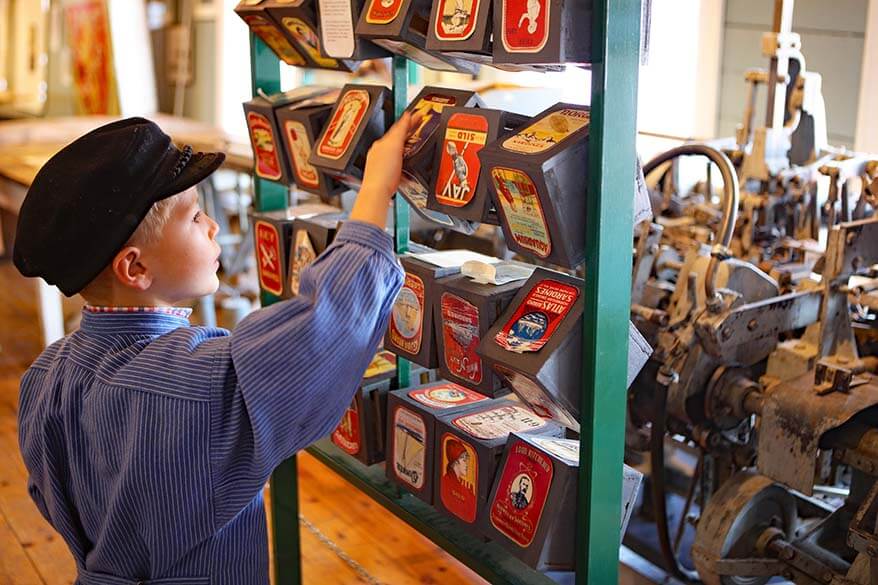
Norwegian Petroleum Museum
You can’t really miss the Norwegian Petroleum Museum in Stavanger. Built as a replica of an oil platform, its very special architectural design will catch your eye immediately. But there is so much more to this museum than its impressive exterior!
There is a lot to see and do in this museum, often chosen as the best museum of Stavanger by guidebooks and travelers alike.
Not only can you learn everything about oil, you will also get a better understanding about the importance of the petroleum industry in Norway. It turned the country that was once on the brink of poverty into one of the most wealthy countries in the world.
There are models of oil platforms and ships, rigs with emergency slides, and even an escape room where you can experience what it would be like to try to evacuate from a burning rig. Children will love this museum as well. There is a question-and-answer trail to follow, lots of hands-on experiences, and a themed playground where the kids can put on a helmet and a uniform and build their own oil platform.
Practical information: You can find more information and opening times on the official website of the Norwegian Petroleum Museum . Count at least an hour or even two for a visit.
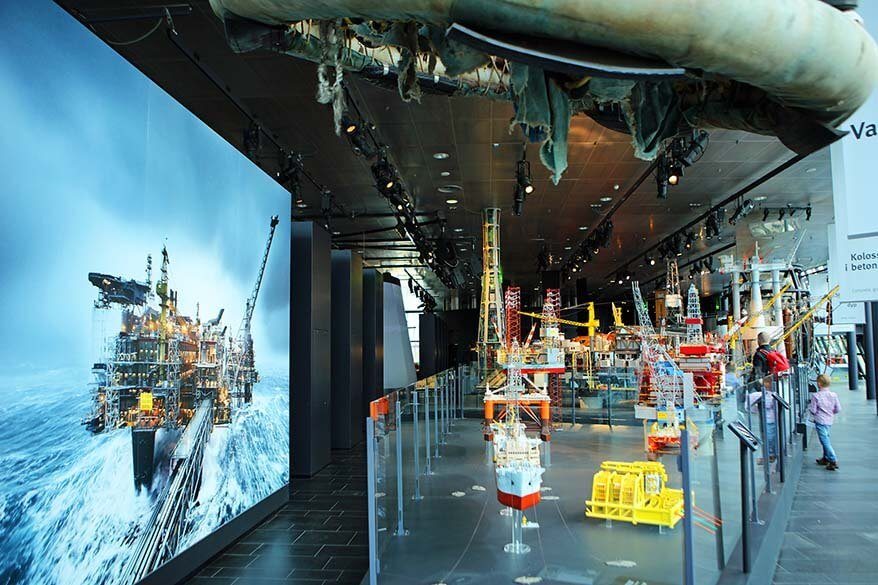
Which museum to visit in Stavanger? Stavanger is not such a big town, but it has so many museums that you could easily spend a week doing nothing else, but visiting them.
If you have just an hour or two in Stavanger, I recommend visiting Gamle Stavanger and the Norwegian Canning Museum. If you have 2-4 hours in Stavanger, visit the Norwegian Petroleum museum as well.
These two museums couldn’t be more different, but I feel that you need to see both to get a better understanding of Norway as a country. If you have more time in Stavanger and want to visit even more museums, you can find the complete selection online.
Stavanger Town Center, Domkirke, and Breiavatnet
Stavanger town center is not very big, so I suggest that you go for a short walk and see some of the main highlights in town.
One of the landmarks you shouldn’t miss in Stavanger is its medieval cathedral – Domkirke . It has been recently restored and is one of the best-kept old churches of Norway. It’s also the only cathedral in Norway that has been continuously used since the 1300s.
Breiavatnet is a small lake with a fountain located in the middle of Byparken park in the center of Stavanger. It’s just a stone’s throw away from the old town and the cathedral and is a nice place for a relaxing stroll.

Lysefjord Cruise
Lysefjord is one of the most beautiful fjords of Norway and one of the main highlights that attracts hundreds of thousands of visitors to Stavanger every year.
Sail deep into the fjord and admire the sheer walls around you, with the most famous of them – The Pulpit Rock – rising over 600 m above the fjord. You’ll pass some tiny islands, caves, and waterfalls. It’s a sight to behold…
There are several ways to experience the Lysefjord. Probably the easiest and the most popular is by taking a boat tour . There are regular ferries connecting various little towns along the fjord, but it’s much easier (and not more expensive) to just take a Lysefjord cruise from Stavanger.
We visited Lysefjord twice. Once on a rainy day when we did the Lysefjord cruise in combination with the Pulpit Rock hike , and then on a sunny day when we sailed all the way to Florli and climbed the world’s longest wooden staircase – Florli 4444 . Needless to say, you’ll have much nicer views if you visit the Lysefjord on a sunny day, but it’s still an impressive trip even if it rains.
Practical information: Lysefjord cruise can be done the whole year. It starts in Strandkaien in Stavanger city center and takes about 3 hours. You can find more information about the fjord cruise here .
TIP: Lysefjord cruise is the most popular trip in Stavanger, so book early, especially when cruise ships are in town.

The Pulpit Rock Hike
Preikestolen , or The Pulpit Rock , is one of the most popular hikes in Norway. Many people come to Stavanger just to hike to Pulpit Rock. Even Tom Cruise was at Pulpit Rock. You can see him hanging by a thread on the Preikestolen in Mission Impossible: Fallout movie.
The purpose of this post is to show you that there is so much more to see and do in Stavanger than just the Lysefjord and the Pulpit Rock hike. At the same time, you really don’t want to miss these two main highlights that Stavanger is famous for!
So if you are fit enough for a moderate 4-hour hike, don’t miss Pulpit Rock! It’s an unforgettable experience and will definitely be one of the highlights of your trip to Norway.
Practical information: Below, you can find a link to an article about our experience hiking to Pulpit Rock (we did this hike with 3 young kids). In that article, you can find all the practical information for the hike as well. Count at least 6-7 hours for the hike including transportation to and from Stavanger.
LEARN MORE: Preikestolen Hike
TIP: If you find the logistics too complicated or rather not go on your own, there are local guides that can guide you to Pulpit Rock as well . One of the biggest advantages of going with a guide is that you can start the hike much earlier before the crowds arrive and/or don’t have to worry about the logistics. This is the most popular guided Pulpit Rock hike tour from Stavanger .
Flørli 4444
If you like outdoor activities and are looking for a more unique experience in Stavanger, then I can highly recommend climbing the world’s longest staircase – Florli 4444 .
A beautiful boat trip deep into the Lysefjord is followed by a strenuous steep climb with some of the most spectacular views you can imagine. Florli 4444 can be done as a day trip from Stavanger, yet you’ll find very few tourists here.
It’s a true hidden gem, but don’t wait till the rest of the world finds out! Visiting Florli and climbing this staircase was the most unique and memorable experience from our trip to Norway.
Practical information: Via the link below, you can read about our experience hiking Florli 4444. In this post, you can also find all the practical information and logistics. You’ll need a whole day to visit Florli from Stavanger and do the Florli 4444 hike. Unless you have a car, by far the best way to do this hike is with a guided tour that includes transfers from Stavanger .
LEARN MORE: Hiking Florli 4444 Stairs
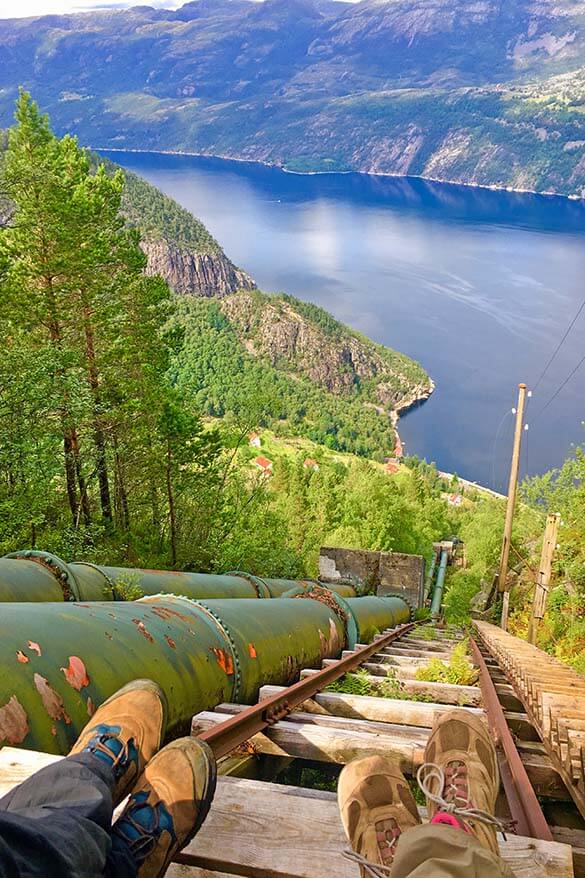
Kjeragbolten Hike
Despite the fact that it’s quite far from town and not the easiest place to get to, Kjerag is a really popular day trip from Stavanger. With its 1084m, it’s the highest mountain in the area that not many people hiked to in the past.
It’s very probable that you’ve seen a picture of a round rock stuck in a mountain crevice, often with a person standing on top of the rock. Being able to take an epic picture like that is the reason why Kjerag has become more and more popular in recent years. It seems that the Instagram-factor of the Kjeragbolten is too big to resist and so more and more tourists come to Stavanger in order to hike to the Kjeragbolten.
Kjeragbolten is a strenuous hike of almost 10 km that takes about 6 hours to complete. It’s the most challenging of the three most popular hikes near Stavanger mentioned in this post and can only be done in summer. Actually, it can be done off-season as well, but you shouldn’t attempt that without an experienced local guide.
Practical information: You can find all the practical information for hiking to Kjerag here . If you don’t have a car and find it too complicated to attempt to get to Kjerag by public transport, you can best book this guided hike from Stavanger (we did the Florli4444 hike with this guide and he’s really good).
The biggest advantage of going with a guide is that you can beat the crowds by going very early in the morning and you don’t have to worry about renting a car, parking, or researching where exactly to hike.
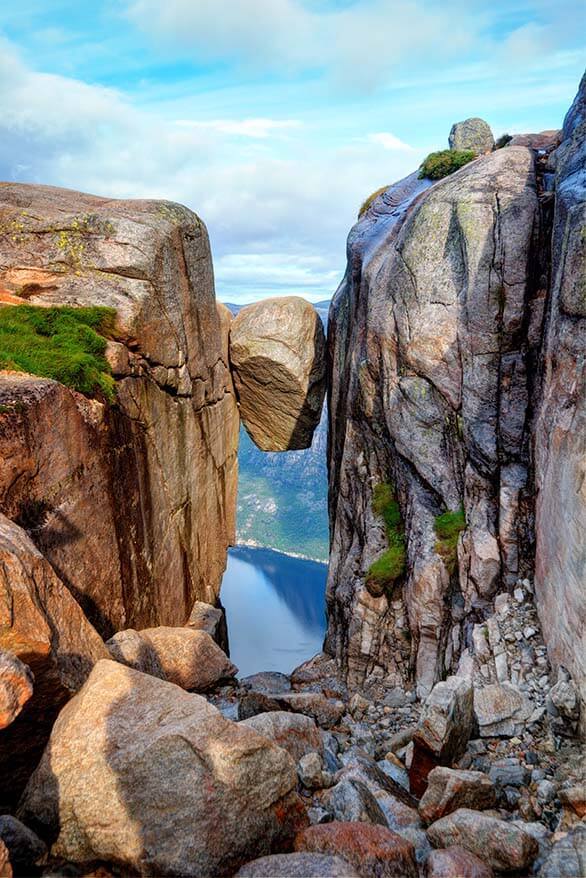
Best Things to Do in Stavanger – Suggested Itinerary for 1 to 4 Days
- If you have just one day in Stavanger , I suggest taking the Lysefjord cruise and then visit the town and the two museums mentioned above.
- If you have two days in Stavanger , you could do Lysefjord cruise and the Pulpit Rock hike one day and then visit the town and the museums on the other day.
- If you have three days in Stavanger , follow the same 2-day itinerary as above and then add either Florli 4444 or Kjerag hike, ideally not hiking two consecutive days.
- You can do all of the things described in this post if you have four days in Stavanger . However, please consider that each of the hikes (Pulpit Rock, Kjeragbolten, and Florli 4444) are quite hard. You can do the Pulpit Rock hike one day and one of the other hikes the following day, but I wouldn’t suggest hiking three days in a row. In that case, you probably best start with either Kjerag or Florli, then take a quiet day and spend it in town, then do another long hike on day 3, and leave Pulpit Rock for the last day, because it’s the least challenging hike of the three.
TIP: If you want to discover Stavanger like a local and see the main highlights in the town itself, I recommend this highly-rated private walking tour with a local guide .
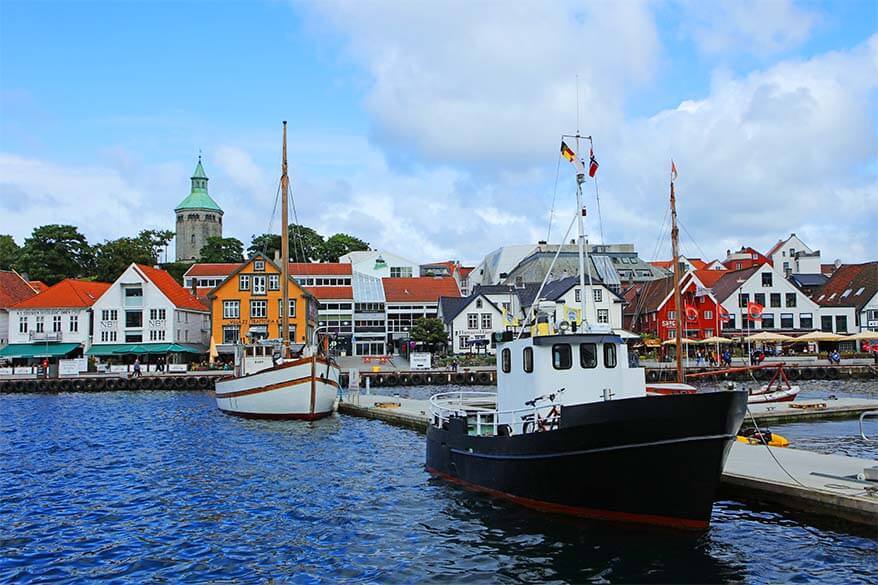
Where to Stay – Best Hotels in Stavanger for Sightseeing
Stavanger is a big town with plenty of accommodation options. It’s also one of the most affordable places to stay in Norway, so good news if you are planning to spend a few days here.
The best places to stay in Stavanger for sightseeing are close to the old town, where you can easily walk to all the main attractions, the bus station, and also to the ferries for your day trips.
Here are some of the best hotels in Stavanger based on the location and customer reviews:
- $$$$$ Hotel Victoria – beautiful historic building and waterfront views.
- $$$$ Clarion Collection Hotel Skagen Brygge – 4* – probably the best location in town for those who want to be by the harbor.
- $$$$ Scandic Stavanger City – best price/quality, especially for big families. We stayed at this hotel and it was perfect.
- $$$ Radisson Blu Atlantic Hotel – the most popular hotel in town . Excellent reviews and a beautiful location next to Breiavatnet lake.
- $$$ Scandic Royal – just a little bit further from the rest (still very central) and has excellent reviews and an indoor swimming pool .
For more information and accommodation options for all budgets, please check our complete guide to Stavanger hotels .
TIP: Using the map below, you can also compare hotels, apartments, and short-term rental accommodations in Stavanger . Simply insert your travel dates and group size, and you’ll see what’s available for your stay. Check it out!
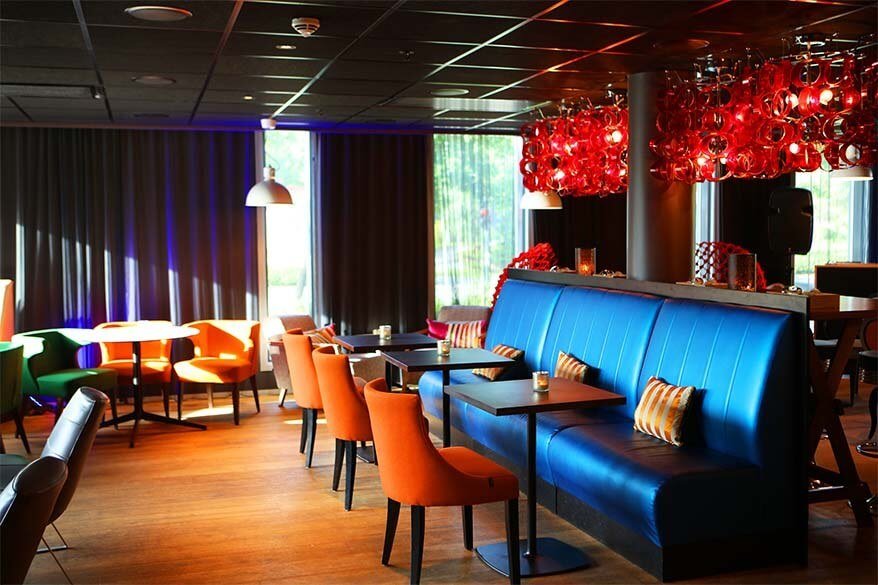
So, this is our guide to the best places to see and things to do in Stavanger. I hope it will help you plan your trip and make the best of your time in this beautiful area in Southwestern Norway.
If you have any questions, feel free to leave a reply below and I’ll do my best to help. Have you been to Stavanger? Let us know your favorite things to do in town.
More tips for your trip to Stavanger:
- Hotels: Where to Stay in Stavanger (Hotels, Apartments, Hostels, Airbnb)
- Best hikes: Pulpit Rock and Florli 4444
- Must-do: Lysefjord Cruise & Pulpit Rock
- Itinerary: Norway Itinerary (Stavanger, Bergen, Flam, Geirangerfjord, and more)
- Packing: What to Wear in Norway in Summer and What to Wear in Norway in Winter
- Budget: How Expensive is Norway
- Norway: For more travel tips and destinations all over the country, please check our Norway travel guide . Also for Lofoten Islands , Northern Norway , and even Svalbard .
If you found this post helpful, don’t forget to bookmark it and share it with your friends. Are you on Pinterest? Pin this image!
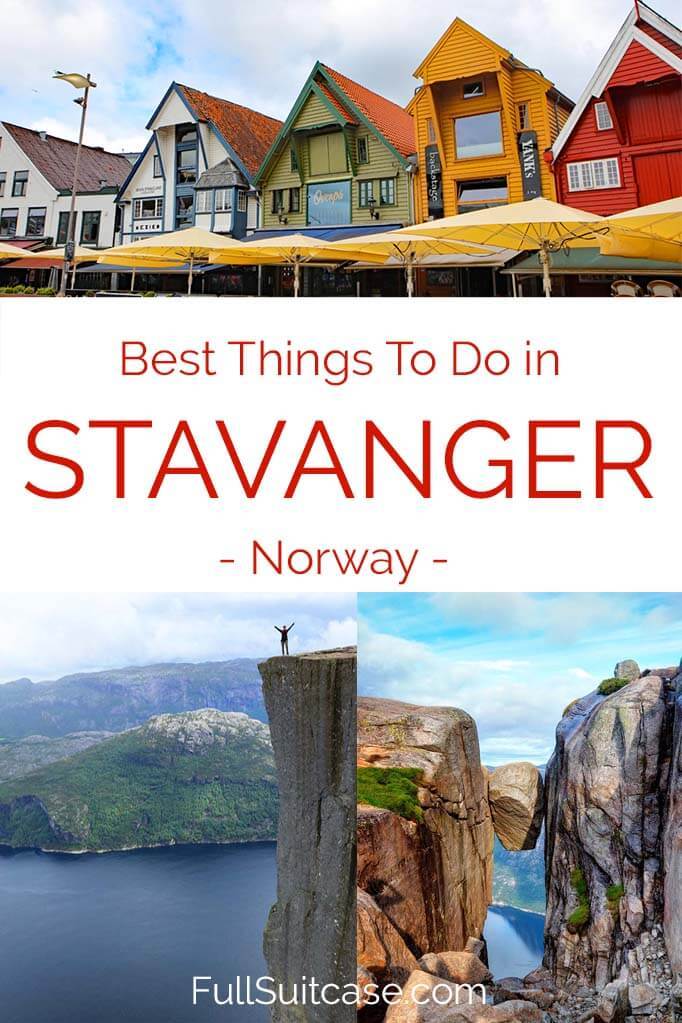
This site uses Akismet to reduce spam. Learn how your comment data is processed .
Thursday 15th of June 2023
Love this guide, very informative!
Saturday 17th of June 2023
Glad to help. Have a great time in Stavanger!
Tuesday 6th of September 2022
Really useful guide to Stavanger, excellent
Thursday 8th of September 2022
Glad to help, Steve, and thanks for your kind feedback. Enjoy your trip!
Wednesday 13th of July 2022
Your post is extremely helpful. Beautifully written Nd covered everything. Thank you! God bless you!
Friday 15th of July 2022
Glad to help, Noureen, and thank you for the kind feedback. Have a great time in Stavanger!
Paul Henderson
Sunday 29th of March 2020
I visited Norway in the mid 90’s, and very much enjoyed my time in Stavanger.
As I recall, we visited the town hall which housed the city government. The tour was great as were the photos of the many past mayors and the stories of the hauntings by past ghosts. I believe that the building then used for city government was once the home of a wealthy merchant.
I would be interested in learning how old that building is.
Someday I will revisit Norway and its very friendly people.
Thank you, Paul Henderson
Monday 30th of March 2020
Hi Paul, we haven't been to the town hall of Stavanger and I can't find much useful information about it online. So I'm not sure if it's open for visits or how old the building is. From what I see, the current municipality building is quite modern, so it's probably not the one you are talking about. You'll just have to go back and see how it is ;). Sorry I can't help you more.
Thursday 21st of November 2019
We are looking to visit Stavanger next year. My great uncle died in the Second World War and is buried in the churchyard at Sola so we want to visit his grave. Your blog has been very helpful in us deciding if we need a hire car or not. Thanks
Monday 25th of November 2019
Glad to help, Corinne. Enjoy your trip. It will be a special experience for you for sure.

Home » Travel Guides » Norway » 15 Best Things to Do in Stavanger (Norway)
15 Best Things to Do in Stavanger (Norway)
The undisputed oil and energy king of Europe, Stavanger’s fortunes were transformed when Norway discovered the Ekofisk oil field 200 miles off the coast in 1969. True to its title of Oljebyen (The Oil Capital) Stavanger has a world-class museum about the Norwegian petroleum industry, opened in 1999 and looking like a small oil platform in the harbour.
Stavanger is a convenient entry point for the Lysefjord and its towering cliffs and the fantasy-like natural lookout, Pulpit Rock, more than 600 metres over the water.
Back in the city you can see what Stavanger looked like before the oil days at the Gamle Stavanger district where shipping offices and a fish-canning factory have been turned into museums.
Let’s explore the best things to do in Stavanger :
1. Gamle Stavanger (Old Stavanger)

After the Second World War the centre of Stavanger was due to be razed and rebuilt in concrete, a plan opposed by the city architect Einar Hedén.
So you can thank him for the preservation of Old Stavanger, a neighbourhood of more than 200 wooden buildings on little cobblestone lanes on the west side of the Vågen bay.
Most are sweet whitewashed weatherboard cottages, and many have restaurants and boutiques on their ground floors.
The area chosen for preservation used to be run down and a little sketchy but is now a desirable, upmarket neighbourhood and a joy to explore on foot.
2. Lysefjord

Stavanger is the most convenient city if you want to experience the wonders of Lysefjord, lying an hour to the east.
Words don’t really do justice to the epic landscapes at Lysefjord, but on a boat trip you’ll have a front row view of majestic walls of rock, waterfalls and idyllic little islands.
The Stavanger-based Rødne Fjord Cruise company schedules tours all year round, and a typical trip will take between three hours and half a day.
One sight that will make an indelible impression is the Preikestolen (Pulpit Rock), a cliff-top 604 metres over the water.
It’s easier to climb than it looks and involves a bus ride and then a flight of stairs.
Needless to say the views from up here mind-blowing.
3. Stavanger Cathedral

In the Storhaug borough not far from the harbour is the oldest and best preserved cathedral in Norway.
It was first raised in the Romanesque style in thefirst half of the 12th century and then given an ornate Gothic chancel in the 13th century after a fire in 1272. Even now, it’s not hard to tell the understated nave apart from the theatrical choir.
Something you can’t help but notice inside is the lavish Baroque pulpit, which was carved by the Scottish craftsman Andrew Lawrenceson Smith in 1658. In the choir keep your eyes peeled for the soapstone baptismal font, carved with foliate patterns and multifoil arches at the end of the 13th century.
In the nave there’s also a group of original Romanesque capitals sculpted with animal motifs.
4. Stavanger Petroleum Museum

Approaching from the North Sea you could mistake the Petroleum Museum and its shiny metallic cylinders for an oil platform.
This is no accident, as the museum chronicles more than 50 years of Norwegian drilling in the North Sea.
Up-to-date and smartly designed, the exhibition has drilling equipment, submersibles, robots, a scale replica of an oil platform, and interactive displays to give a sense of life on board.
You can also find out about the technological leaps since the 1960s, and get to know the sophisticated underwater systems and state-of-the-art ships that will sustain the industry into the future.
5. Sverd i fjell (Swords in Rock)

On a peninsula poking into the Hafrsfjord in the Madla neighbourhood is a solemn monument recording a great naval battle.
After the Battle of Hafrsfjord, fought some time at the end of the 9th century the Viking chief Harald Fairhair was able to proclaim himself the first King of Norway, uniting a number of petty kingdoms under one ruler for the first time.
At 10 metres high, the monument is three bronze swords plunged into the rock and was designed by the sculptor Fritz Røed and unveiled by King Olav V in 1983. The largest of the swords represents Harald Fairhair, while the two smaller ones symbolise the vanquished pretenders.
The monument also represents peace as the swords are stuck in the rock and can’t be removed.
6. Norwegian Canning Museum

At Øvre Strandgate 88 in Old Stavanger, the Canning Museum is in a canning factory that was in business from the 1916 to the 1950s.
With architecture dating back to 1841, the factory was abandoned until 1975 when the museum opened.
What’s exciting is that all of the machinery is still in situ and the enthusiastic guide will explain and show you how freshly caught fish (sprats) were smoked and packaged, as well as working conditions on the factory floor.
The equipment is in working order, and on Tuesdays and Thursdays in summer you’ll be able to try classic Norwegian smoked brisling right out of the oven.
7. Stavanger Art Museum

Under the auspices of the multi-location “Museum Stavanger”, this institution is on the west shore of the Mosvatnet lake, southeast of the city centre.
The collection centres on the 19th-century Stavanger landscape artist Lars Hertervig, who was a member of the Düsseldorf School but moved back to Stavanger after a mental breakdown and only achieved renown posthumously.
His works are joined by a strong assortment of art by Edvard Munch, Kitty Kielland and Christian Krohg.
A permanent modern installation here is the Broken Column by the British sculptor Antony Gormley.
The museum also has a special workshop for children to express themselves creatively, and stages up to four temporary exhibitions at one time.
In early 2018 the highlight was a show on the textile artist Frida Hansen.
8. Øvre Holmegate

Up to 2005 this street on the east side of the Vågen was rather nondescript.
But as part of the “Kul Kultur” project Øvre Holmegate was totally revitalised after the local hairdresser Tom Kjørsvik proposed a way to transform it.
First it was closed off to road traffic, and then, using a colour scheme devised by the artist Craig Flanagan, the houses were painted in eye-popping colours.
They are shades of green, turquoise and pink, and on the back of the revival exciting businesses like trendy bars, cafes and boutiques have moved in.
9. Stavanger Maritime Museum

Also in one of the whitewashed wooden houses in Old Stavanger is a museum all about the history of shipping, fishing and shipbuilding in southwestern Norway.
You can enter a general store as it would have looked in 1910, stocked with anything from milk to paint and seafaring equipment.
There’s also an office interior that once belonged to the Monsen Shipping Company, in business in Stavanger for 165 years.
And on the top floor is a reconstruction of a sail-making workshop, with work benches and tools.
You can also see how an affluent merchant’s family would have lived at an apartment interior from the early 1900s, complete with study, kitchen, parlour and dining room.
The museum preserves two seaworthy sailboats: A traditional Hardangerjakt sloop launched in 1848, with a mast 19 metres high, and the Wyvern yacht designed by Norwegian naval architect Colin Archer and christened in 1897.
10. Breidablikk Museum

Also managed by the Stavanger Museum AS is an elegant villa built in the Eiganes neighbourhood in the early 1880s.
It was commissioned by the rich merchant and ship owner Lars Berentsen, and prominent architect Henrik Nissen made the plans.
Breidablikk is designed like a Swiss chalet with exaggerated eaves, and has neo-Romanesque and Gothic influences.
A team of artists like painter and decorated Louis Anton Jacobsen worked on the interiors, which have a superlative standard of workmanship and illustrates the lofty lifestyle of Stavanger’s bourgeois in this period.
Nearly all of the decoration and furnishings are from the 1800s, while the layout of the surrounding English garden hasn’t changed.
Next to the house is a barn from 1852, containing agricultural tools and horse-drawn carriages from the period.
11. Skagenkaien

When summer arrives the street lining the east side of the Vågen is cleared of road traffic and becomes a lively pedestrian street with lots of outdoor seating and stalls for festivals.
Skagenkaien could well be the most vibrant nightlife street in the city, home to restaurants and bars in handsome wooden houses, mostly from the 19th century and punctuated by hotels.
One of the finest can be found at no.
16 and dates to 1770, with the Skjøna Skagen restaurant on its ground floor.
At the innermost part of the street you can check out the classy boats in the marina, while further up are the quays where ferries depart for the Lysefjord.
12. Vitenfabrikken (Science Factory)

Down in Sandnes, a train or car ride south of Stavanger is a terrific science museum that opened in 2008. The Science Factory explores the fields of technology, physics, chemistry, astronomy and mathematics, and has some inspiring installations like a Foucault Pendulum 11 metres high, a Tesla coil and the inventions of Leonardo da Vinci.
In winter, don’t miss the fourth floor, which is an observation terrace set up with telescopes.
The groundbreaking 19th-century mathematician Niels Henrik Abel was born in this part of Norway, and “Abel’s Sketchbook” is a special interactive exhibition investigating the common ground between art, science and technology.
13. Jernaldergården

At Stavanger’s Ullandhaug suburb is a reconstructed Iron Age farm, revived in the 1970s after lying abandoned for 1,500 years.
The farm was first settled in the Migration Period in the 4th century, but was burned down and deserted about 200 years later.
The feted archaeologist Bjørn Myhre investigated the site in the late 1960s, when it was recognised as one of almost 200 Iron Age farms in the low-lying Jæren region.
On a hillside dotted with sheep, you can take an English language tour to learn about ancient folklore, watch ancient crafts in action, light a fire with firesteels and spin wool.
An interesting thing about the huts is that they were designed with small doorways, not to keep the warmth in but to make potential home invaders vulnerable to an attack by residents.
14. Sola Beach

Stavanger can get temperatures above 20°C in July and August, and on clear, sunny days you could pack off for the beach at Sola.
Found 15 kilometres from the southeast of the city, this 2.3-kilometre arc of fine sand is also just a kilometre or two from the airport.
And while sunshine might not be guaranteed, one thing you can bank on is wind and so Sola Beach is a hit with kitesurfers and windsurfers.
On a walk you’ll stumble upon a German Second World War bunker at the southern end of the beach.
And also just in from the dunes on the south side is the Solastranden Golfklubb, an 18-hole links-style course, posing a challenge for its unpredictable breezes.

For more wide open skies and cinematic beaches, carry on south down the coast to Klepp, under half an hour by road from Stavanger.
The protected natural landscape in the Jæren region has the longest strip of flat sandy coast in all of Norway, adding up to 11 kilometres and fringed by dunes sustaining a rare diversity of wildlife.
In contrast to the rest of Norway’s coastline there are no fjords and the topography is low-lying.
At the Orre Friluftshuset (recreation centre) you can find out about local hiking and cross country ski routes and check out exhibitions, all within a quick jaunt from Orrestreanda beach.
15 Best Things to Do in Stavanger (Norway):
- Gamle Stavanger (Old Stavanger)
- Stavanger Cathedral
- Stavanger Petroleum Museum
- Sverd i fjell (Swords in Rock)
- Norwegian Canning Museum
- Stavanger Art Museum
- Øvre Holmegate
- Stavanger Maritime Museum
- Breidablikk Museum
- Skagenkaien
- Vitenfabrikken (Science Factory)
- Jernaldergården
Stavanger Touristeninformation
Die Touristeninformation in Stavanger befindet sich am Strandkaien, direkt am Hafen zwischen den Kreuzfahrtschiffen und der Altstadt Gamle Stavanger.
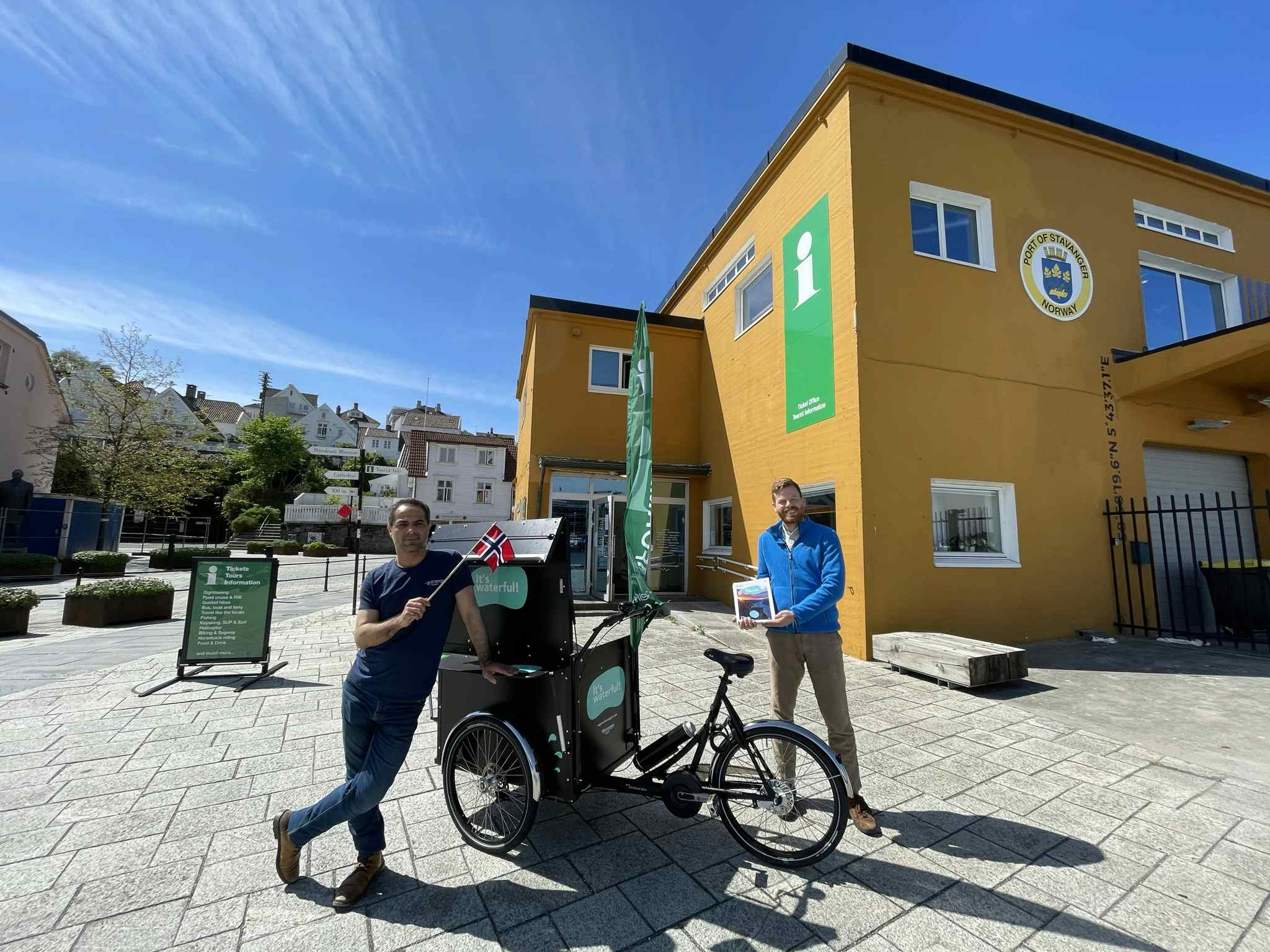
Unsere Mitarbeiter sind gerne für dich da, kennen und lieben die Region und werden all ihre Möglichkeiten ausschöpfen, um dir ein unvergessliches Erlebnis bieten zu können.
Qualifizierte Beratung und Empfehlungen
Bei uns erhälst du immer gute und tagesaktuelle Tipps, was du in unserer Region unternehmen kannst. Neben der offiziellen Touristenbroschüre für die Region Stavanger und der offiziellen Karte City & Regional Maps verteilen wir Broschüren und Karten für lokale Sehenswürdigkeiten, Aktivitäten und Unterkünfte.
Ticketverkauf für Sightseeingtouren und Aktivitäten
Wir verkaufen eine große Auswahl an Ausflügen in den Lysefjord, Wanderungen mit professionellen Führern sowie Fahrkarten für den Transport zu berühmten Sehenswürdigkeiten wie Preikestolen und Kjerag. Bei uns bekommst du Tickets für Sightseeing-Touren, Fjordfahrten und viele andere unterhaltsame Aktivitäten. Wir helfen dir gerne, eine passende Aktivität oder Tour für dich und deine Reisebegleitung zu finden!
- Chili Chocolate
- Citysightseeing Strømma
- Engøyholmen Kystkultursenter
- Explore Lysefjorden
- Fjord Events
- Get Guided Norway
- Lysefjorden Adventure
- Nordic Paddling
- Das Norwegische Erdölmuseum
- Ryfylketurer AS
- Ski Boot nach Sauda
- Stavanger RIB
- Viking House
Kaufe dir gerne ein Andenken, das dich später an deinen Urlaub in der Region Stavanger erinnern wird. Wenn du Freunden und Verwandten zu Hause einen physischen Gruß schicken möchtest, findest du bei uns eine Auswahl an Postkarten und Briefmarken.
Öffnungszeiten
Hauptsaison (1. Juni - 31. August):
- Montag - Freitag: 08.00 - 18.00
- Samstag und Sonntag: 09.00 - 16.00
Rest des Jahres:
- Montag - Freitag: 09.00 - 16.00
- Samstag und Sonntag: geschlossen
Der Rest des Jahres
Hauptsaison: 1. juni - 31. august.
- Strandkaien 61
Einrichtungen
- Frühlingszeit
Wo ist Stavanger Touristeninformation ?

Touropia Travel
Discover the World

16 Best Things to Do in Stavanger, Norway
By Jamie Gambetta · Last updated on May 22, 2024
The fjords, ivory beaches, and craggy cliffs are just a sample of what one can expect as they travel Stavanger. The dramatic backdrop infuses a sense of adventure into a town that already offers its fair share of history.
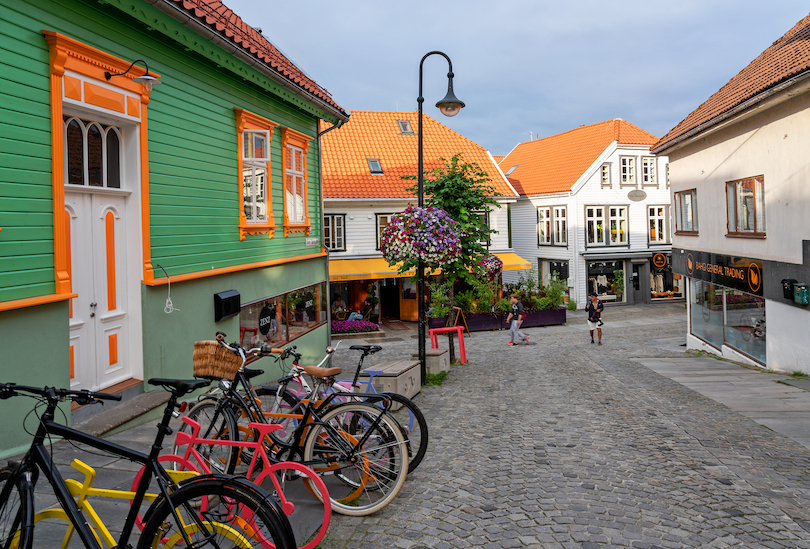
One of Norway’s oldest cities, museums in Stavanger explore the early days of Vikings and traverse the rich heritage of fishing. The Old Town preserves over 150 traditional wooden buildings. These envelop ancient cobbled streets that are an adventure themselves.
As you wander, you’ll quickly discover many things to do in Stavanger. Foodies will revel in the city’s rich culinary scene spread through markets, local gems and high-end restaurants. In fact, it’s something all travelers will come to love. With Stavanger’s adventurous ways, you’ll be sure to work up an appetite.
16. Breidablikk
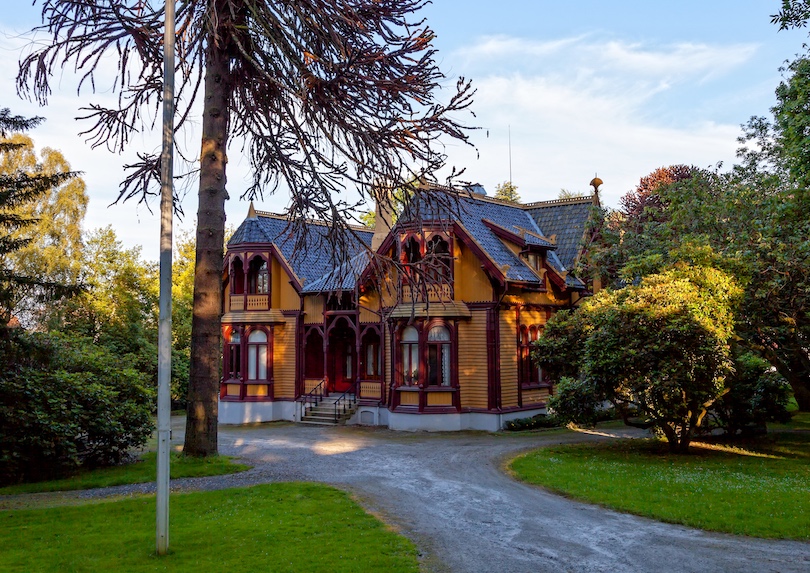
Constructed in 1881 for the merchant and shipowner Lars Berentsen, Breidablikk has been meticulously preserved as a museum. It offers a glimpse into the affluent lifestyle of the family during the late 19th and early 20th centuries.
This architectural gem epitomizes the Swiss chalet style, featuring a wooden exterior adorned with intricate carvings and ornate details, creating a visually stunning manor. A visit to Breidablikk is akin to stepping back in time, allowing you to immerse yourself in local history. This, along with the artistic, architecture, and interior décor trends of the era.
Conclude your exploration with a leisurely stroll through the gardens designed by P.H. Poulsson. It provides an ideal conclusion to your journey, offering a tranquil space for reflecting on what the era was like.
15. Iron Age Farm
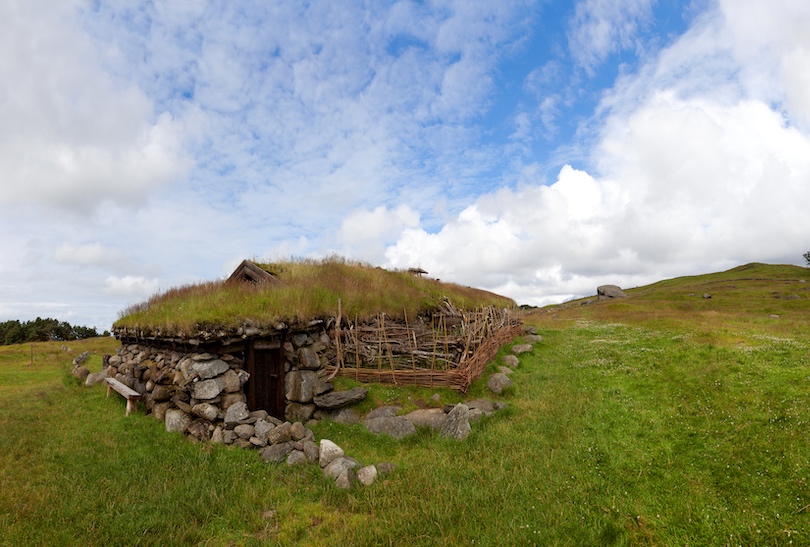
Forget transporting you centuries back in time, the Iron Age open-air museum offers a portal into life over a millennium ago. This reconstructed farmstead allows visitors to revel in the daily routines of Iron Age living in Norway (500 BC to 1000 AD).
Explore the farm’s various buildings, including barns, stables, and workshops. These were crucial for crop storage, animal husbandry, and tool crafting. Constructed using traditional methods and materials, the buildings provide an authentic experience.
Travelers can interact with knowledgeable staff adorned in traditional Iron Age attire, passionate about sharing the farm’s history and answering any queries. It’s a unique opportunity to step into the past and witness a bygone era firsthand.
14. Kjeragbolten Hike
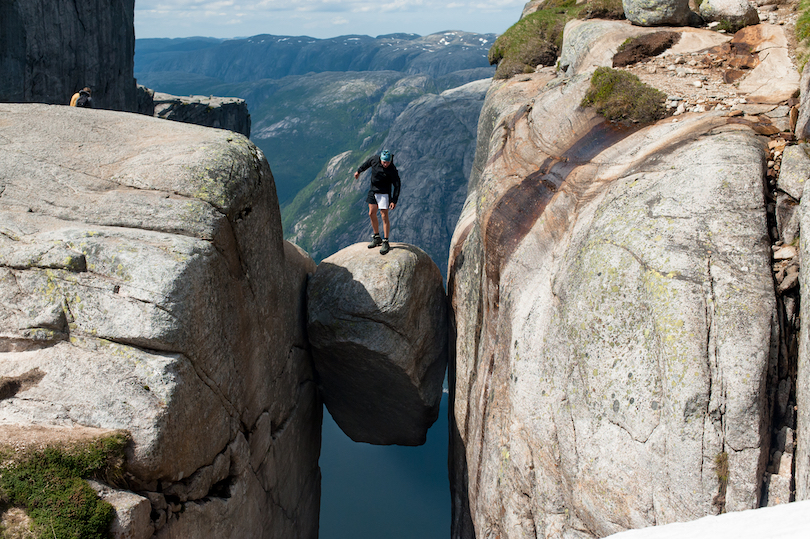
Embark on one of Norway’s most iconic hikes at Kjeragbolten! The trail commences in Øygardstøl village, totaling about 10 kilometers round trip and requiring 6-8 hours on average. Geared towards experienced hikers, the trek is of moderate to hard difficulty, characterized by steep and rocky terrain.
The highlight is the renowned Kjeragbolten, a massive boulder wedged between cliffs, dangling 984 meters above the Lysefjord. This spot invites daring hikers to capture photos and confront their fear of heights by standing on the boulder. Caution is crucial, as any misstep could have serious consequences.
The hike ascends to the Kjerag summit, soaring impressively at 1,110 meters above sea level. At this vantage point, hikers can relish panoramic views of the Lysefjord and surrounding mountains, completing an exhilarating adventure in the Norwegian wilderness.
13. Museum of Archaeology
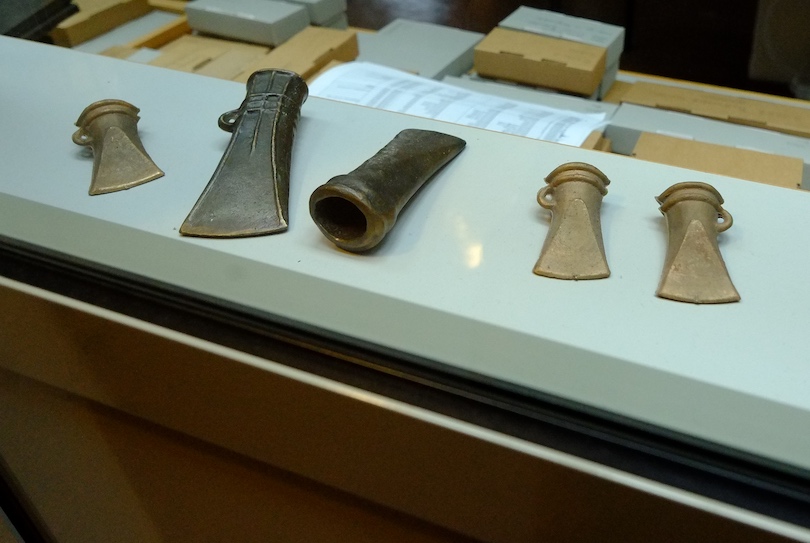
For those wanting to take a deep dive into the history and culture of Scandinavia, the Museum of Archaeology is your top spot. The initial section of the museum delves into the prehistoric era, exhibiting artifacts and remnants from the Stone Age, Bronze Age, and Iron Age.
Here, you can discover well-preserved tools, weapons, and jewelry. Each providing insight into our ancestors’ lives and their ingenious adaptations to the environment.
Afterwards, you’ll transition to the Viking era. The museum features a replica of a Viking house. Displays capture the nuances of Viking existence, spanning clothing, food, and traditions.
With so much to see, we recommend their guided tours for a deeper understanding of our prehistory. This ensures you don’t miss the chance to unravel the rich narratives preserved within.
12. Valberg Tower
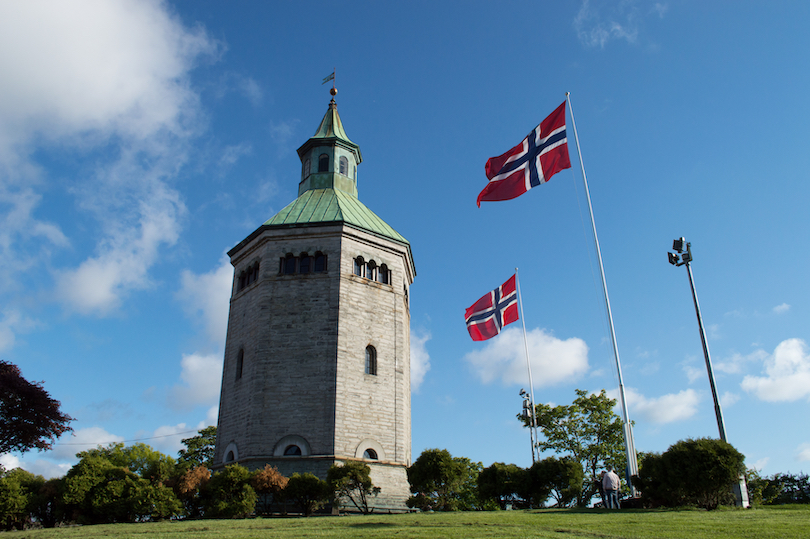
Situated in Valbergparken, Valber Tower is a medieval tower which offers stunning views of the city and the surrounding areas. The tower has a rich history and has served various purposes throughout the centuries. Such as being a defensive fortress to a prison and a fire watchtower.
As you approach the Valber Tower, you can’t help but be in awe of its impressive architecture. The tower stands tall and proud, with its sturdy stone walls and a conical red roof. It is a perfect representation of the medieval era and the necessity of such a landmark.
To reach the top of the tower, you have to climb a spiral staircase. Once there, however, you will be rewarded with views that have protected the city throughout history.
11. Skagenkaien
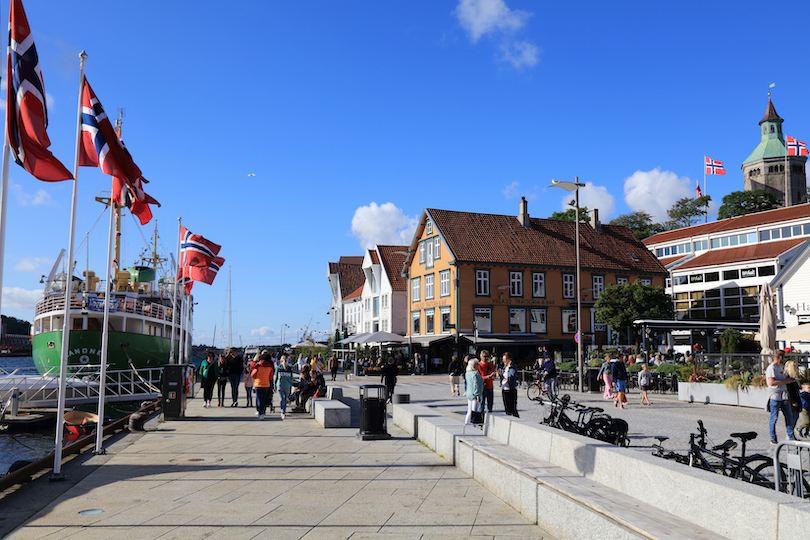
Take a stroll along Skagenkaien and bridge the gap between the city and the sea. Here, you’ll uncover the historical link to Stavanger’s broad global connections.
This iconic waterfront showcases vibrant, historic wooden houses that once belonged to fishermen and sailors. Today, they’ve been tastefully repurposed into delightful shops and restaurants. You can spend hours exploring these shops, to find a range of souvenirs, handmade crafts, and delectable seafood.
For a perfect evening, plan to enjoy a coffee or beer while witnessing the sunset over the bay. As the colors dissolve into the night, the waterfront transforms into a lively hub, attracting both locals and tourists to the outdoor cafes and restaurants. It’s a charming convergence of history, commerce, and community along the idyllic Skagenkaien.
10. Flor og Fjære
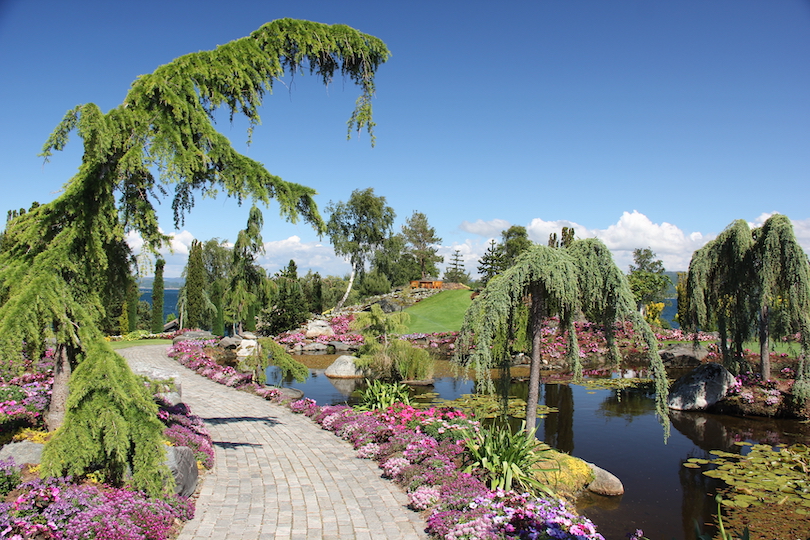
For a taste of palm-tree paradise within Norway, Flor og Fjære is a destination worth discovering. Begin your journey with a brief ferry ride from Stavanger harbor to the island of Sør-Hidle. Stepping off the ferry, you’re greeted by breathtaking views of the North Sea and the surrounding islands.
Welcomed by friendly staff, Flor og Fjære unveils a garden laboriously nurtured by the Hidle family since its establishment in 1965. What was once a rocky, barren island has been transformed into a lush haven with over 5,000 plant species from around the globe.
A highlight of the visit is the delectable lunch served in the garden’s restaurant, featuring traditional Norwegian dishes crafted with fresh garden ingredients. Indulge in your meal amidst stunning views of the garden and the sea.
9. Stavanger Cathedral
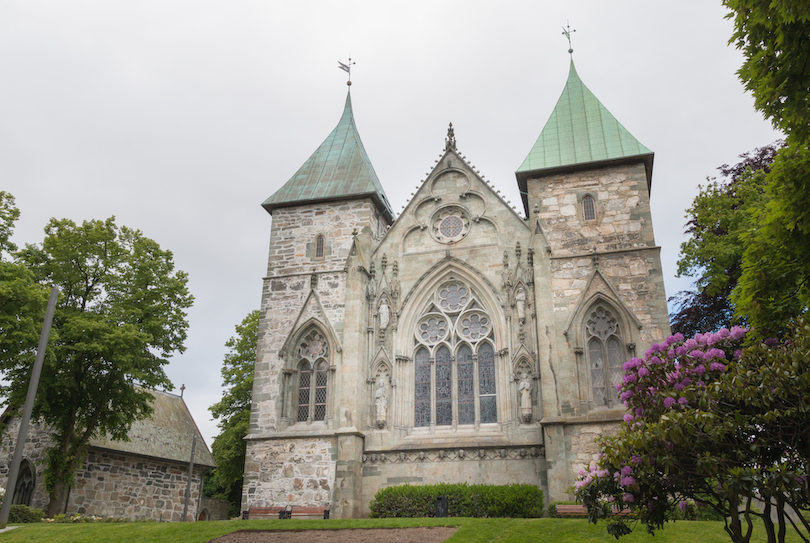
Known affectionately as Norway’s Best Kept Cathedral, Stavanger Cathedral is a captivating architectural gem. Its origins trace back to the 12th century, making it the oldest cathedral in Norway still in active use.
A visit to Stavanger Cathedral unveils the 17th-century masterpiece, the cathedral’s renowned pulpit. This intricately carved work of art stands as a pinnacle of Baroque craftsmanship in Norway.
Situated in an area overlooking Vagen, a settlement with only a few hundred residents when the cathedral was constructed. This central point would go on to play a pivotal role in Stavanger’s gradual growth over the centuries. So many have raised the question: which came first? The Cathedral or Stavanger?
8. Stavanger Maritime Museum
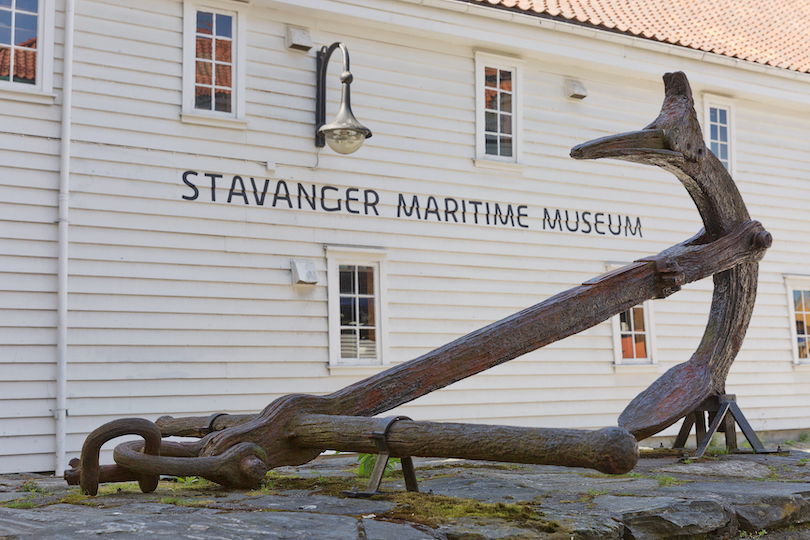
Immerse yourself in maritime wonders at the Stavanger Maritime Museum, a captivating labyrinth of interconnected, meticulously restored merchant buildings. The exhibition intricately unfolds the shipping and trading history of Stavanger over the past 200 years.
Appealing to all, especially families with children, the museum offers a quayside marketplace for little ones to engage in the vibrant life of 1950s Stavanger. Children can dress up and embark on role-playing adventures, such as navigating a fjord boat, managing a post office, tending to a shop, and running a market stall. Adding to the charm, the museum owns two historic sailing vessels, the 1848 Anna of Sand and the 1896 Wyvern. Both are open for exploration when in port. It’s a maritime journey through time suitable for all ages.
7. Swords in Rock
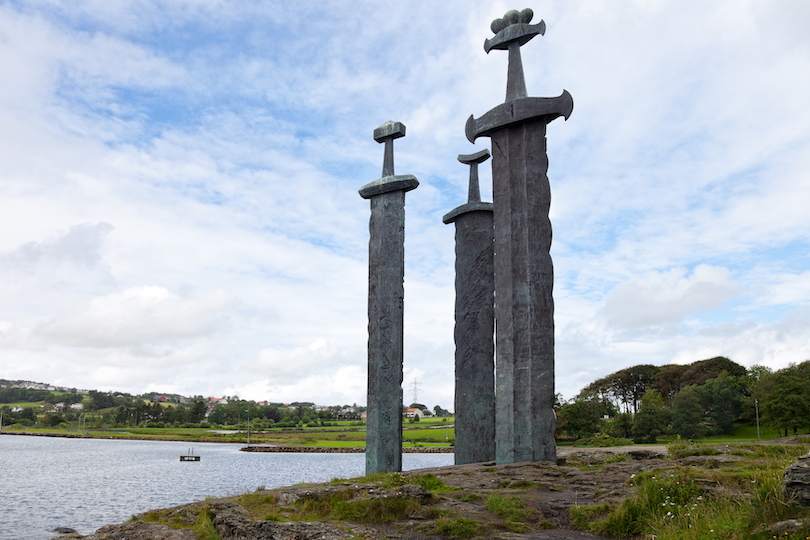
Standing tall as a significant symbol of Norwegian identity, Swords in the Rock represents the country’s rich history and cultural heritage. All the while embodying a commitment to peace and unity.
Crafted by Norwegian sculptor Fritz Røed, the three bronze swords commemorate the historic Battle of Hafrsfjord in 872. This was a pivotal moment when Harald Fairhair unified Norway into a single kingdom.
Sitting in a picturesque location overlooking the fjords of Stavanger, the monument becomes part of the scenic Hafrsfjord recreational area. Here, a charming bike route and walking path run along the fjord, offering a delightful year-round escape while visiting the monument.
6. Norwegian Canning Museum
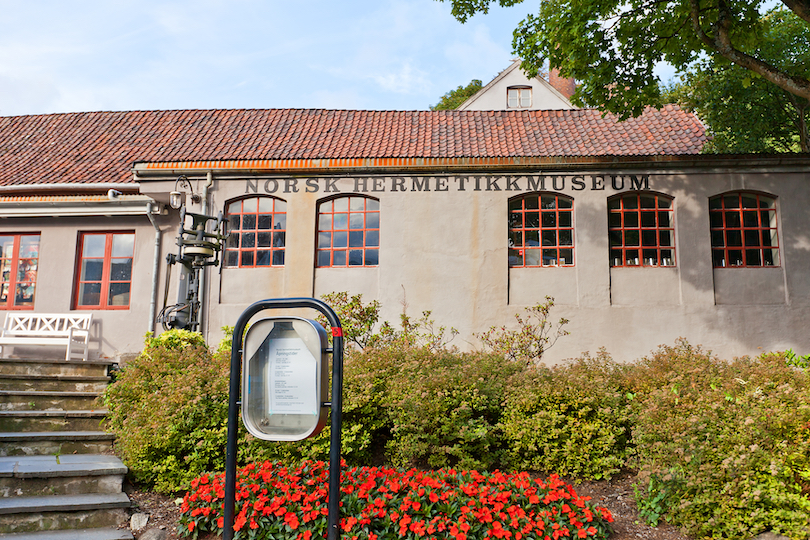
Stavanger, once renowned as the “canning capital” of Norway, played a central role in the nation’s economy. The Norwegian Canning Museum masterfully unfolds the canning industry’s ascent and decline through its engaging exhibitions.
A highlight of the museum is the guided tour, providing a firsthand look at the canning process using well-preserved original machinery. The evolution of this process over the years comes to life, guided by knowledgeable and passionate docents who encourage visitors to experience everything.
A fun exhibition is the fish can labels. Dating back to the 1880s, these labels initially prioritized content over packaging. However, as standardized cans emerged, distinct labels became crucial for individual producers.
By 1900, vibrant and carefully designed labels became the norm. While not all on display, the museum holds a collection of over 32,000 labels, underscoring Norwegians’ profound historical understanding of marketing.
5. Visit Pulpit Rock
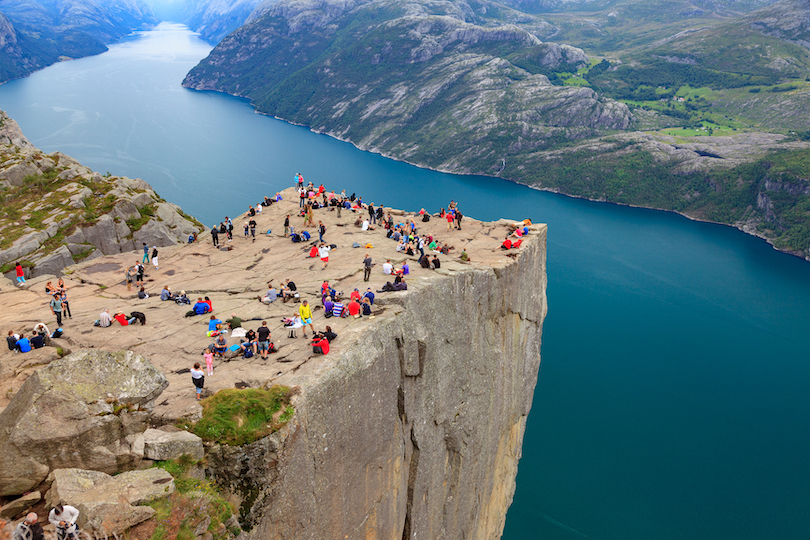
Standing at an impressive 604 meters above the Lysefjord, Pulpit Rock (Preikestolen) is one of Norway’s most renowned hikes. The approximately 6-kilometer round trip to Pulpit Rock takes about 4-5 hours, featuring well-marked trails with some steep and rocky sections.
Surrounded by tall trees and the soothing sounds of nature, the ascent offers a serene and peaceful experience. The optimal hiking season spans from May to October, while special equipment and a guide are advisable from November to April.
Upon conquering the challenging yet enjoyable hike, the summit of Pulpit Rock awaits, treating you to breathtaking views. The sheer cliff drop and panoramic fjord vistas create an awe-inspiring scene.
4. Fargegaten

Known for its vibrant hues, Fargegaten is arguably one of the most colorful streets in Norway. Come see for yourself! Situated within Stavanger’s historic city center, Fargegaten boasts a lively atmosphere with picturesque, vibrant buildings lining both sides.
Distinctive to Fargegaten is each building’s unique color scheme, a purposeful choice by local artists to foster individuality and creativity. Beyond the elaborate facades, Fargegaten hosts a variety of independent shops, cafes, and restaurants.
Explore boutique clothing stores, antique shops, and cozy cafes offering delightful Norwegian pastries and coffee. Whether you seek unique souvenirs or gifts, Fargegaten provides the perfect backdrop for leisurely wandering and discovery in the heart of Stavanger.
3. Norwegian Petroleum Museum
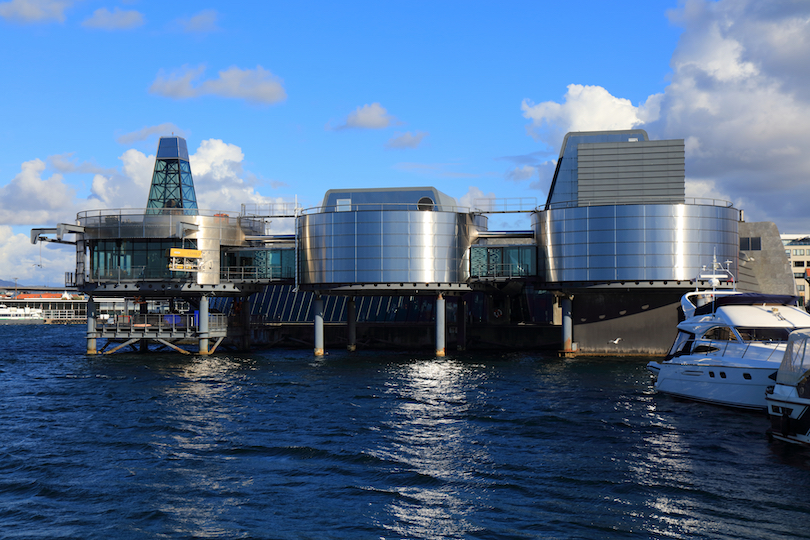
Norway’s most crucial industry, particularly offshore operations, is vividly portrayed at The Oil Museum (Oljemuseet). The exhibitions trace the historical evolution of the oil industry. This commenced with North Sea exploration and the construction of steel and concrete platforms. Before progressing to modern production ships and sub-sea systems.
Designed by an architectural firm, the museum itself is a striking structure. Appropriately, it resembles an oil platform when viewed from the outside and has become a major landmark in the Port of Stavanger. Officially opened on May 20, 1999, by King Harald V, it has since become the most visited museum in town.
Beyond historical displays, the museum highlights the future of the oil industry, showcasing innovative technology and sustainable practices for a greener and more environmentally conscious energy sector. Witnessing these efforts is both enlightening and inspiring.
2. Lysefjord cruise
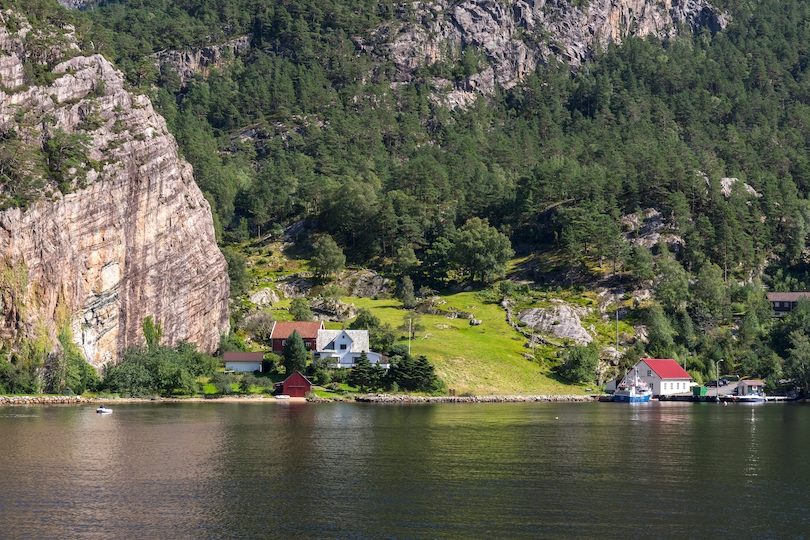
Experiencing the stunning beauty of Stavanger and its surroundings through a Lysefjord cruise is one of the most rewarding things to do in Stavanger. This is an unforgettable journey into a 26-mile-long fjord surrounded by towering cliffs and dramatic landscapes. Alongside breathtaking views, it’s an unforgettable opportunity to explore Norway’s iconic landmarks.
As you navigate the fjord, marvel at the glacier-carved Preikestolen (Pulpit Rock), a towering rock formation reaching into the sky above Lysefjord. Next, you’ll be in awe as the boat carefully approaches Hengjane Falls, offering a chance to feel the refreshing spray of mountain waters.
Choose to enjoy the striking scenery from the comfort of the boat’s interior or step onto the spacious sundeck. Either way, the Lysefjord cruise provides a unique and memorable perspective on Norway’s southernmost fjord.
1. Gamle Stavanger
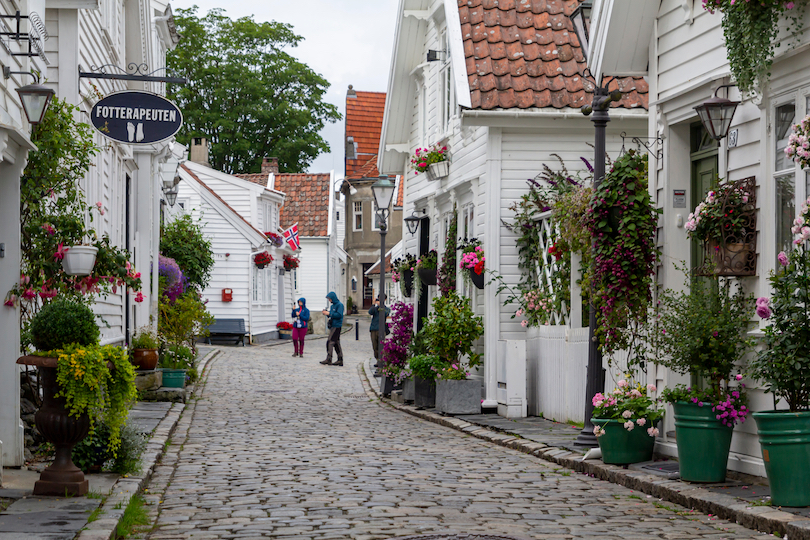
Sitting in the heart of Stavanger, Gamle, translating to “Old Town” in Norwegian, is a delightful neighborhood steeped in history. Dating back to the 18th century, its charm lies in well-preserved wooden houses, cobblestone streets, and alluring alleyways. Each opens a window into the city’s rich heritage and traditional architecture.
This historic quarter comes to life during various events, like the annual food festival and traditional Christmas market. These lively events provide an excellent opportunity to immerse yourself in local culture, engage with the friendly locals, and experience the vibrant spirit of Gamle.
In addition, Gamle hosts many institutions, like the Canning Museum, and art galleries. Each spotlights Stavanger’s cultural legacy and contemporary art scene.
Best Time to Visit Stavanger
A very popular port of call for cruise ships on their way to the Norwegian Fjords , Stavanger lies right in the very southwest of the country, surrounded by water. July and August see the most visitors arrive as this is when the weather is warmest and days are longest. Gladmat, Norway’s largest food festival, also takes place then.
May, June and September also attract plenty of people as temperatures average 13 to 16°C (55-61°F). The summer months are the best time to hike or island hop with swimming also possible if you can bear the coldish water. You may find though that the famous Pulpit Rock viewpoint is packed with people.
Outside of these busy months, Stavanger is rather quiet. A constant stream of visitors check into its hotels though, either commuting or on business connected to the petrol industry. In the cold, dark winter months, you can enjoy its charming center all decked out in Christmas decorations or go skiing in the nearby mountains. Whenever you visit, make sure to pack a coat as each month sees between 16 and 26 days with at least some rain. July to January is the rainiest period with spring being relatively dry.
Where to Stay in Stavanger
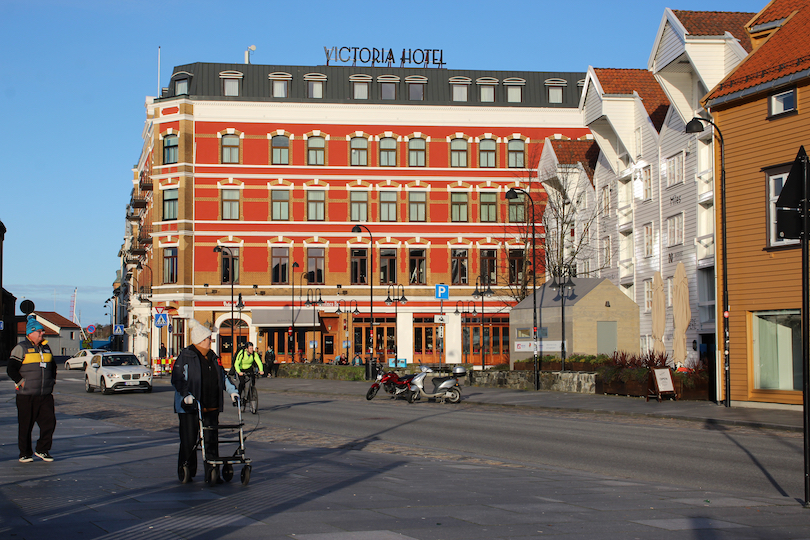
Situated in the southwest of Norway, this enchanting coastal city captivates with its picturesque landscapes, lively culture, and impressive architecture. Opting to stay in the city center is highly recommended. Doing so places you at the heart of iconic landmarks, a bustling food scene, galleries and parks for a leisurely afternoon.
Perched by the waterfront, Hotel Victoria occupies a charming Victorian-style building dating back to 1900. The rooms, tastefully appointed with classic decor, feature amenities such as a TV with a variety of channels and complimentary Wi-Fi. Ideally situated, a mere 10-minute stroll from Stavanger Train Station, the hotel places you amid many city highlights.
Frogner House , also conveniently positioned in the heart of Stavanger, was recently renovated in 2023. The hotel offers spacious rooms featuring fully equipped kitchens. Don’t miss “Fangene på Fortet” in the basement. This is an escape room-style activity perfect for families.
How to get there
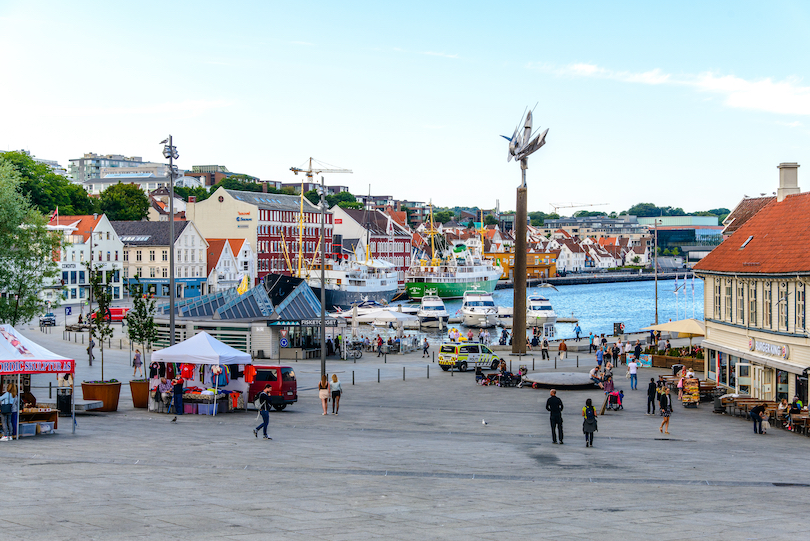
Reaching your destination is easiest by air, with Stavanger Airport providing direct flights from major international hubs like London Heathrow, Amsterdam, and Copenhagen. From the airport, you can take a taxi or a bus to the city center, which is only a 15-minute drive away.
Alternatively, you can embark on a picturesque train ride from various Norwegian cities or utilize a bus service such as Kystbussen and Nor-Way Bussekspress. A daily ferry service run by Fjordline between Bergen and Hirtshals in Jutland calls in Stavanger, on its way from Jutland to Bergen in the mornings, and on its way back in the evenings.
For those inclined towards driving, renting a car is a viable option, but route planning and weather checks are crucial.
Map of Tourist Attractions in Stavanger
Share this post:
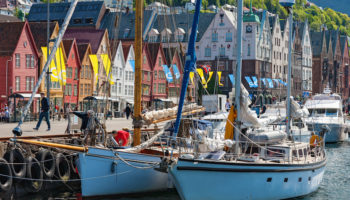
15 Best Cities to Visit in Norway
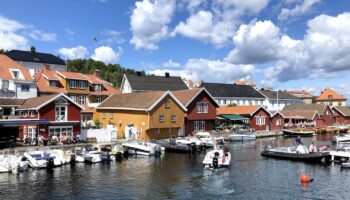
How to Spend A Day in Kragero, Norway
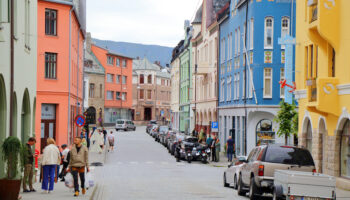
17 Best Places to Visit in Norway
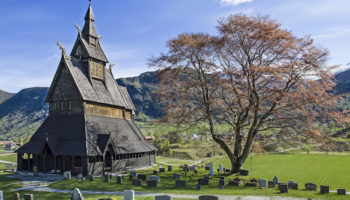
10 Most Beautiful Stave Churches in Norway
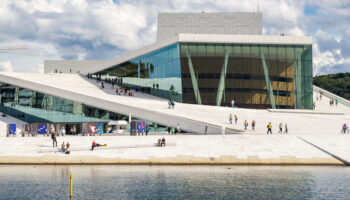
23 Top Tourist Attractions in Oslo, Norway

10 Most Beautiful National Parks in Norway
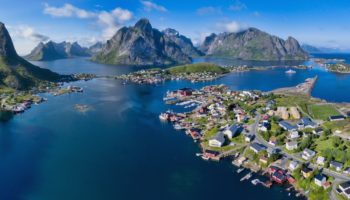
Discover the Beauty of the Lofoten Islands in Norway
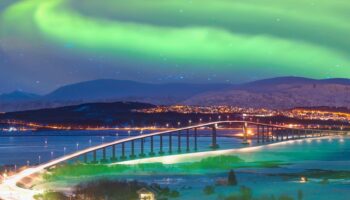
10 Top Destinations in Northern Norway
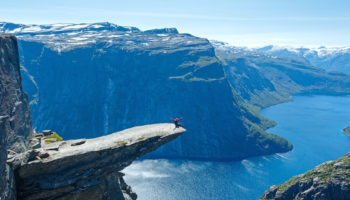
Top 10 Reasons Why You Should Visit Norway
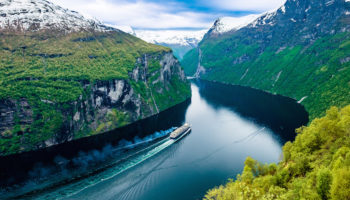
See What Makes Geirangerfjord, Norway So Incredible
Reader interactions, leave a reply cancel reply.
Your email address will not be published. Required fields are marked *
This site uses Akismet to reduce spam. Learn how your comment data is processed .
10 things you may not know about Stavanger
Rich history, culture and cuisine on tap. Stunning natural attractions at hand. Excellent and easy travel connections. It’s no wonder Stavanger, Norway’s fourth-largest city and urban heart of the scenic southwest, makes for the perfect base of adventure operations for your fjord holiday.
This charming and cosy city of 135,000 inhabitants has long prospered as a center of shipbuilding, fish canning and, most recently, offshore oil production.
But don’t let the industrial bona fides of Norway’s “Oljebyen” (Oil Capital) fool you: Stavanger is the perfect jumping-off point for nature-based adventures, too. It’s also packed with plenty of heritage for the history buff in you.
Interested? Intrigued? Here are 10 fun facts about Stavanger that are sure to seal the deal.
Top rocks!
Stavanger is a stone’s throw from two of Norway’s most breathtaking natural attractions — Preikestolen (Pulpit Rock) and Kjeragbolten (the Kjerag Boulder). Just a short bus ride away from the city center, both of these Instagrammable natural wonders perched high above the Lysefjord can be hiked in one day.
Preikestolen is a steep cliff looming 604 m. (1,942 ft), above the fjord. The Kjerag Boulder, meanwhile, is a large rock perilously wedged in a mountain crevasse some 984 m. (3,228 ft), above Lysefjord. Edging out onto these iconic sites for sky-high, bird’s-eye views of the fjord is a once-in-a-lifetime, bucket list type of thrill. Keep an eye out for BASE jumpers!
Fjord highlights — and hideouts
Stavanger is also a short boat ride from the stunning, 42-km (26-mile) Lysefjord, lined with sheer cliffs and mountains soaring more than 1000 m (3,300 ft).
Although the fjord is only 13 m (43 ft) deep at its mouth, by the time ships pass under Preikestolen cliff, its depth reaches 400 m (1300 ft).
Several boat cruises depart from Stavanger daily. Marvel at Preikestolen’s storied heights from the safety of sea level and explore Fantahålå, or “Vagabond’s Cave,” where a group of suspects on the run famously once hid from local police.
Life’s a beach. Beaches? Stavanger? Yes!
The popular, 2.3-km (1 mi) Solastranden has been named one of the world’s most beautiful beaches by London’s The Sunday Times. In summer, it beckons not only swimmers but wind- and watersports enthusiasts, as well. Spot some traces of World War II-era structures nearby, too.
Solastranden is part of the larger, 70-km-long (43 mi) Jæren region of beaches , parts of which are state-protected plant and wildlife reserves.
Oil is king
While commerce in Stavanger once meant shipyards and fish canneries, all that changed back in 1969 when oil was discovered in the North Sea. The city was chosen as the new oil industry’s on-shore center — and the boom times for Stavanger, and Norway, began.
Much of the local industry is now centered on petroleum production. It’s said production of offshore oil platforms alone accounts for around 40% of manufacturing jobs.
Medieval — and modern — marvels
Although it only legally became a municipality in 1838, Stavanger is actually one of Norway’s oldest settlements. The area was first populated as long ago as the last Ice Age, and a busy market town had arisen by the 12th century.
Stavanger is home to Norway’s oldest cathedral, whose completion year — 1125 — also marks the city’s traditional founding date. The sanctuary is an architectural and cultural jewel not to be missed.
Meanwhile, the best-preserved medieval monastery in Norway, Utstein Abbey, hugs the southern shore of Klosterøy island. Dating from the 13th century and restored in the 20th, the abbey now serves as a concert and convention venue. It can be reached by a short 30-minute drive via the Byfjord Tunnel, a 5,875-m (3.65-mi) wonder in its own right that was once Europe’s deepest tunnel, reaching 223 m (732 ft) below sea level.
A wooden urban wonderland
Gamle Stavanger, or Old Stavanger, is the city’s postcard-perfect historical heart — and visitor haunt. Some 173 well-preserved wooden structures, dating as far back as the 18th century, grace a small area just west of Vågen, the city’s harbor. It’s Northern Europe’s largest such collection.
Mainly small, white cottages, the wooden houses were nearly razed in a wave of post-war urban renewal but were saved by city architect Einar Hedén.
Today, they still serve as private homes but also house many art galleries and handicraft boutiques popular with tourists.
Gamle Stavanger, however, isn’t the be-all and end-all of the city’s wooden architectural heritage. There are actually around 8,000 such picturesque structures dotting the urban landscape, ranging in period and style from Empire to Art Nouveau. Open your smartphone camera app and snap away!
Speaking of Stavanger’s charming centre, it’s compact enough that you can reach most attractions easily on foot. Within a few steps, you’ll find innovative museums devoted to a variety of disciplines.
Not far from the petroleum museum (norsk oljemuseum), Gamle Stavanger is home to the Norwegian Canning Museum, located in a preserved fish cannery that operated from 1916 to the mid-1950s.
The museum is part of the wider Stavanger Museum system that also includes the Stavanger Art Museum, Stavanger Museum of Natural History and the Norwegian Printing Museum, among others. (Extra, extra! It’s a little-known fact that Stavanger has always been one of Norway’s premier printing centers.) All kinds of shopping and dining is at hand, too.
Cruise a “colorful street”
Smack-dab in the centre of Stavanger, you’ll find Øvre Holmegate, inspiration for the trendy hashtag #fargegata (or “#colorstreet”) and so named for its bright, multihued buildings.
Home to many of those aforementioned retail and culinary musts, the area’s referred to as Stavanger’s take on London’s Notting Hill. Hipsters and hangers-on alike owe all the fabulousness to local hairdresser Tom Kjørsvik, who spurred a renaissance back in 2005 when he hatched the repainting scheme with help from artist Craig Flannagan.
Street art’s a thing here
It’s not just Øvre Holmegate that’s colorful. All of Stavanger is something of a mecca for street art, and its buildings serve as canvasses for scores of outdoor works by leading street artists from around the globe.
The annual NuArt Festival, first held nearly two decades ago and annually each September ever since, is a celebration of this ever-more-popular artform. The official festival app offers exact locations for each work of street art in the city, along with info on the artist and date of creation.
The festival foundation also runs a gallery, and visitors can avail
themselves of guided street art tours, too. Stavanger: Scandinavia’s outdoor art gallery!
A feast of festivals
NuArt is just one of many major festivals taking place in Stavanger each year. Street art not your thing? How about eats? Gladmat is Scandinavia’s largest annual food festival, attracting more than 250,000 foodies each July.
MaiJazz, meanwhile, has drawn jazz fans to Stavanger each May for over two decades and is now known as one of Norway’s leading music events.
Things get even more niche with Norway Chess, an annual June gathering of game enthusiasts whose latest titleholder is the country’s own chess rock star, Magnus Carlsen.
There’s an event for nearly every interest, from wine festivals and science weeks to marathons and ski competitions.
Plan a visit to Stavanger and indulge your pet passion!
Experiences from Stavanger
Silent lysefjord & preikestolen cruise, preikestolen express bus round trip, related articles, how to celebrate may 17th like a true norwegian, explore icy magic: five fun facts about huskies, why lofoten is one of the best places for kayaking.

Plan & Book
Flight information, infinity mileagelands, business travel, please select your country / region of residence, travel news, during the hurricane's impact on houston, u.s., please be aware of the in-flight service adjustments.
Jul 9, 2024
The catering service company that cooperates with EVA Air in Houston, U.S. has been affected by the hurricane. In-flight service for 7/9 BR52 Taipei-Houston outbound flight and 7/10 BR51 Houston-Taipei inbound flight will be impacted.
Thank you for your understanding of any inconvenience that may cause.
This site uses cookies.
EVA Air's websites use cookies and similar technologies for the best experience on our website, including personalized services, ads and traffic analysis. These cookies include targeted media cookies and advanced analytics cookies. By clicking on "Accept", you agree to the use of cookies. You can change your cookie preference by clicking on the "Change your cookie settings" button.
For more detailed information on the cookies we use, please check our Cookie Policy .
Essential cookies are essential for the operation of our website that will let you move around our website freely and use functions on the websites. These cookies don’t gather your personal identifiable information that could be used for marketing and are not disclosed to any third party.
I've traveled to 20 countries in 2 years. I found the most stunning coast in one of the least-visited countries.
- I traveled to Timor-Leste in May and spent four days exploring its capital city.
- Timor-Leste is one of the least-visited countries in the world.
- While inaccessible and expensive, it was worth visiting for its unspoiled coastline.

I've spent the past two years traveling to 20 countries . While most of these countries — from the Maldives to France — were among the world's most popular, it was the off-the-beaten-path destinations that I enjoyed most.
Last month, I traveled to Timor-Leste , a country located in the South Pacific. The country comprises the eastern part of Timor Island and two smaller islands. At 5,800 square miles, it's comparable in size to the Bahamas.
It's also the 14th least-visited country in the world and the least-visited in Asia, according to a January report from CEOWorld magazine . Some 81,000 tourists visited Timor-Leste in 2023 — putting it just ahead of Chad and Sierra Leone, per the report.
The lack of tourists is not a direct result of the pandemic either. Back in 2019, only around 80,000 tourists had visited, per the National Statistics Directorate Timor . While researching my trip, I struggled to find information online for tourists — save for a handful of short vlogs on YouTube. I ended up having to learn along the way.
Here are seven things that surprised me about Timor-Leste.
1. It's difficult to fly there — and even harder to get around.
Only a handful of airlines fly to Dili, the capital, where the only international airport in Timor-Leste is located. Tourists can only fly to Dili from Bali , Indonesia, and Darwin, Australia. I was in Bali for three weeks, so I decided to fly with the Indonesian budget airline Citilink. Dili's airport is tiny — there's only one departure gate and one runway.
There are no ride-hailing services in Timor-Leste. While there are some taxis to help tourists get around, I only spotted them around the airport and in the city center. I ended up meeting Fernando, a local, who took me around the city on a scooter. I found that traveling via scooter was the best way to sightsee from the coasts to the surrounding mountains.
2. There aren't many options when it comes to accommodation.
While Hilton plans to open a hotel in Dili's business district later this year, when I visited, there were no luxury resorts or international hotel chains in Timor-Leste. With only around 70 hotels and guesthouses in the country listed on Google Hotels, lodging choices online were limited. I booked three nights at Timor Plaza Hotel & Apartments, a three-star hotel located next to a small mall in the city center.
After chatting with other travelers, I found many were staying in local guesthouses by the beach. They're usually a simple set-up, comprising a small room with a bed, mosquito net, and a fan. You can spot signs at the side of the road showing if there are rooms available for the night. Since there are very few tourists in the country, chances are you can negotiate a rate and book your stay on the spot.
3. Locals use US dollars — which means it's more expensive than other nearby countries.
The US dollar is the official currency. While used interchangeably, The East Timor Centavo is only minted in coins and pegged to the US dollar at $1 to 100 centavos. This makes Timor-Leste more expensive than many other countries in Asia.
Related stories
In Bali, a plate of nasi goreng — an Indonesian fried rice with satay — costs an average of between $3 to $4.50. In Dili, I paid between $10 and $15 for a similar dish. In Bali, renting a scooter for a day can cost as little as $3. In Dili, it costs over five times more, between $25 and $35.
4. Not everyone speaks the same language.
While Portuguese and Tetum are the official languages of Timor-Leste, English and Indonesian are the working languages. However, only 13.5% of locals speak Portuguese, according to the US Department of State .
The majority of locals I met in Dili spoke Tetum and Indonesian. Due to the high number of ethnic groups in Timor-Leste, there are at least 16 additional languages between them.
As I grew up in Singapore and can speak some Indonesian , when locals didn't speak English, that was my fallback language. Although Fernando, my guide, told me tourists needed to be careful when conversing in Indonesian. He noted that some locals may get offended, considering the complicated history between these countries. I found that it was best to ask what language they prefer to speak when in doubt.
5. Very few American chains operate in the country.
Only a handful of American food chains exist in Timor-Leste, mostly in Dili's city center. I spotted a Burger King and a Gloria Jean's Coffee outlet next to each other right outside the hotel where I was staying — McDonald's doesn't operate in Timor-Leste. As an adventurous eater, I had all my meals at locally-run eateries and cafés, where I had Indonesian and Timorese fare.
A few stores sell American brands like Head and Shoulders and Maybelline when it comes to toiletries and makeup. But no-name brands are more common and are sold for much cheaper.
6. The landscapes are some of the most pristine in the region.
I found that Timor-Leste offered some of the most scenic views in Asia.
I spent most of my time at Cristo Rei Beach — which is overlooked by an 88-foot-long statue of Jesus Christ — at the northern tip of Dili. It's a natural white-sand beach with the clearest waters I have ever seen — even clearer than the Maldives . I could see the outline of the mountainous Atauro Island from the coast, famed for its rich, colorful reefs.
After traveling the region extensively, I found Dili the most scenic capital city I've seen. Its gorgeous coastline is flanked by towering mountains.
7. You won't find the local nightlife listed online — but you'll find it in the streets.
On Google Maps, there are only a few local nightlife establishments listed — and most have no photos, reviews, or information. But my guide, Fernando, shared that locals love drinking the local palm wine and dancing to Kizomba, a dance genre originating from Angola, in the late evenings.
I was fortunate to be in Timor-Leste on May 20, during National Day. It marks when the country gained independence from Indonesia . I found thousands of people partying by the beach and hundreds of motorcycles revving down the coast to celebrate the day. The energy was unexpected — and a memorable surprise that I'll never forget.
- Main content
Flight delayed with clear skies? United Airlines will show you why weather is to blame
- United Airlines will now send passengers real-time weather maps to explain flight delays.
- Specialized customer service representatives will sit alongside operations managers to get a better understanding of what’s causing delays across the network.
Airlines are typically not held responsible when weather delays flights, because the cause is seen as being out of their control by regulators.
Get more news like this delivered to your inbox by signing up for our Travel newsletter here .
It can be confusing when you’re looking up at a clear blue sky but your flight is delayed by weather. United Airlines knows that and will now send passengers real-time weather maps to explain those kinds of delays.
Because flights usually cover large distances that cross different regions of the country, the weather over the Great Plains, for example, can cause significant headaches on transcontinental flights even if the conditions are perfect on both coasts.
“With more people traveling this summer than ever, we wanted to give our customers an easier way to stay connected to real-time information about their flight and texting was the simplest solution,” Jason Birnbaum, United’s chief information officer, said in a statement. “We know customers appreciate transparency and by combining innovative technology-enabled tools with people power, we can give more people, even more in-the-moment details about their flight.”
According to United, specialized customer service representatives will sit alongside operations managers to get a better understanding of what’s causing delays across the network. They can then send texts or emails to travelers to explain what’s going on.
When weather is behind the disruptions, those updates will include links to live, local weather maps that highlight the conditions affecting their flight. United said customers also can access weather maps on its app.
What you’re entitled to when your flight is delayed by weather
That said, United offers flexible rebooking options after delays or cancellations. All airlines are required to provide full refunds if a flight is canceled for any reason.
The Department of Transportation has a dashboard that outlines airlines’ customer commitments for delays and cancellations that are in the carriers' control, which typically include those caused by staffing or mechanical problems.
Zach Wichter is a travel reporter for USA TODAY based in New York. You can reach him at [email protected].
The Key Points at the top of this article were created with the assistance of Artificial Intelligence (AI) and reviewed by a journalist before publication. No other parts of the article were generated using AI. Learn more .
Advertisement
Supported by
America’s Divided Summer Economy Is Coming to an Airport or Hotel Near You
The gulf between higher- and lower-income consumers has been widening for years, but it is expected to show up especially clearly in travel this season.
- Share full article

By Jeanna Smialek
Reporting from Washington and Paris
The travel industry is in the midst of another hot summer as Americans hit the road and make for the airport to take advantage of slightly cheaper flights and gas. But the 2024 vacation outlook isn’t all sunny: Like the rest of the American consumer experience this year, it is sharply divided.
Many richer consumers — always the lifeblood of the travel industry — are feeling good this year as a strong stock market and rising home values boost their wealth. While they have felt the bite of rapid inflation over the last few years, they are likely to have more wiggle room in their budgets and more options to ease the pain by trading down from name brands to generic, or Whole Foods to Walmart.
Poorer families have had less room to maneuver to avoid the brunt of high prices. Although the job market is strong, with low unemployment and wages that have risen especially rapidly at the bottom of the income scale in recent years, some signs of economic strain have been surfacing among lower-income Americans. Credit card delinquencies have risen , many lower earners report feeling less confident in their own household finances, and companies that serve lower-income groups report that they are under stress.
The gulf between higher- and lower-income consumers has been widening for years, but it is expected to show up especially clearly in travel this summer. Surveys show that richer households are more optimistic about their ability to take trips, and services that they are more likely to use — like full-service hotels — are flourishing. Budget hotel chains, by contrast, are expected to report a pullback.
“If you go to upscale, you’re actually seeing growth there,” said Adam Sacks, the president of tourism economics at Oxford Economics. “A lot of that has to do with the different financial situations of different income groups.”
Bookings, survey responses and spending trends so far suggest that the travel industry will see muted but healthy growth this summer and in 2024 as a whole. That growth is expected even after several years of breakneck vacationing as people took “revenge” for the trips they missed during the pandemic.
Outbound international travel is still booming , domestic leisure travel is holding up, and even business travel is coming back after a sharp decline that started in 2020. While airfare-dollar spending might fall somewhat because flight prices have come down, airports are reporting record traffic on key days. AAA is forecasting that Fourth of July travel will smash last year’s strong performance.
“We’re seeing lots of people on the road; we’re seeing people taking flights,” said Joshua Friedlander, the vice president of research at the U.S. Travel Association. “We think this is a sustainable level of growth.”
But that resilience is not uniform across income groups. Spending on travel “picked up and was largely driven by consumers with discretionary income,” the Federal Reserve Bank of Richmond reported in the Fed’s latest anecdotal release about national economic experiences. “Conversely, low-to-moderate-income consumers were reportedly pulling back” because of “higher costs leading to tighter household budgets.”
That adds to an established trend: Rich people tend to spend a lot more on splurges like travel. The top two-fifths of the income distribution accounts for about 60 percent of spending in the economy; the bottom two-fifths, about 22 percent. The divide is more extreme when it comes to vacationing. Lower-income people have historically spent about 19 cents on the dollar that a high-income person devotes to lodging, transportation and other travel-related purchases, based on one analysis.
Recent economic trends could exacerbate that. Lashonda Barber, an airport worker in Charlotte, N.C., is among those feeling the pinch. She will spend her summer on planes, but she won’t be leaving the airport for vacation.
Ms. Barber, 42, makes $19 per hour, 40 hours per week, driving a trash truck that cleans up after international flights. It is a difficult position: The tarmac is sweltering in the Southern summer sun; the rubbish bags are heavy. And while it’s poised to be a busy summer, Ms. Barber’s job is increasingly failing to pay the bills. Both prices and her home taxes are up notably, but she is making just $1 an hour more than she was when she started the gig five years ago. While that is not the standard experience — overall, wages for lower-income people have grown faster than inflation since at least late 2022 — it is a reminder that behind the averages, some people are falling behind.
“I don’t take personal trips,” Ms. Barber said, explaining that it had been several years since she had taken a family vacation, and that when she did, she drove.
That comes in stark contrast to what is happening at the other end of the income spectrum.
Parker Hess is director of rooms at The Allison Inn & Spa in Oregon’s Willamette Valley, where rooms start at $645, amenities include plush robes and bucolic wine country surroundings, and business is booming.
“Our rates are the highest they’ve ever been,” Mr. Hess said, and while a customer will occasionally push back, many do not even ask about the price.
Hotel room rates are forecast to divide sharply this year. Jan Freitag, national director of hospitality analytics at the CoStar Group, said he was forecasting that full-service hotels like Marriott and Sheraton would post 2.1 percent room-rate growth this year, while midscale room rates would be essentially flat. He expects economy hotel room rates to outright decline as poorer travelers retrench.
“The lower-income consumer seems to be making a choice between things that they have to have versus the things that they want to have,” Mr. Freitag said. “You have to pay your credit card bill, you have to pay your car insurance, and those things are expensive right now.”
That gap is also evident in surveys. In a Bank of America Institute summer travel survey, a higher percentage of households with annual household incomes below $75,000, roughly the national median, said they did not have plans to go away this year compared with previous years.
“This may indicate some extra caution developing among these consumers around making the financial commitment necessary to take a holiday,” analysts wrote in their report.
That said, the analysts noted that the pullback was not yet evident in actual credit and debit card data, which has so far shown that lower-income consumers continue to spend. That’s an important caveat: Just because people report financial strain in surveys does not necessarily mean they will cut back.
And from an industry perspective, even if the surveys are prescient and poorer households do pull back on vacations this year, demand from richer people alone could be enough to fuel a strong — if not enthusiastic — performance for the summer travel season.
That strong demand could add fuel to the overall economy. Domestic travel adds to U.S. economic growth. International trips do not, but they signal consumer confidence.
On a full Sunday afternoon flight from Charles de Gaulle Airport outside Paris to Washington, D.C., Erica Reasoner, 42, was returning from two weeks in Italy and France with her husband and two children.
She and her family had stayed with friends and relatives for about half of their trip, and Ms. Reasoner said they had not taken an international trip last year. A resident of Denver, she said that her job in custom homebuilding was stable and business solid, and that while she had noticed higher grocery prices, recent inflation had not caused problems for her family’s budget.
“We planned this trip for so long that the state of the economy didn’t really play into our decision,” she said. Not everyone, she said she realized, was so fortunate.
Jeanna Smialek covers the Federal Reserve and the economy for The Times from Washington. More about Jeanna Smialek

IMAGES
VIDEO
COMMENTS
Stavanger RIB; Viking House; Souvenirs sold. Buy yourself a souvenir that will later remind you of your visit to the Stavanger region. If you want to send a physical greeting to friends and relatives at home, you will find a selection of postcards and stamps. Opening hours at the Stavanger tourist information. Main season (1 June - 31 August):
Stavanger/Sandnes is Europe's energy capital with a thriving offshore energy sector. In Sandnes, you'll find recreational areas with natural icons such as Kjeragbolten and the Dalsnuten mountain peak. Sandnes has grown steadily in the last few years and many new buildings have appeared, including the new town hall by the harbour. A few ...
Stavanger Travel Resources: Find a Hotel - Car Rental - Book Tours. And when visiting Norway, don't forget travel insurance. Central to this burgeoning street art movement is Nuart, a festival and year-round collective that have transformed the city into a living gallery. Stavanger's streets and alleys are adorned with works that range from ...
Living in Stavanger. If you do move to Stavanger, you're unlikely to feel alone. The city is home to more than 30,000 foreign-born residents among its population of almost 150,000 people. The overall population is forecast to grow to 149,946 by 2030 and 158,003 by 2050. Local people in Stavanger city centre.
Stavanger Travel Guide. Norway's energy capital has an international feel and a fascinating street art scene. Here's our guide to the best of Stavanger. The country's oil and energy HQ may not strike you as the most obvious city to visit, but Stavanger has a lot going for it. The oil wealth (known as the "black gold") means the city has a ...
Contrasts in the Stavanger region. Experience everything from long-stretched beaches to a winter wonderland in Sirdal. The beaches offer adrenaline-filled adventures such as surfing, kiting, swimming and hiking. If you are driving along the Norwegian Scenic Route Jæren, you will see all the variations in the typical farmland landscape.
The tourist information office in Stavanger is located right at the harbour at Strandkaien 61. Here you can find information about what to see and do in the Stavanger region. You can also buy tickets for many different sightseeing trips, souvenirs, post cards and stamps. Note: Closed on public holidays, but open every day during high season.
The city has a rich cultural life, and you can also have an amazing culinary experience here. Stavanger is known for fishing, agriculture and industry, and populate by around 120.000. Stavanger offers a lot of cultural experiences from museums, galleries, and music events to festivals. In 2008 Stavanger was elected cultural city of Europe.
Map of Tourist Attractions in Stavanger. Best Time to Visit Stavanger. 1. Pulpit Rock (Preikestolen) Pulpit Rock (Preikestolen) Highlights: A stunning 609-meter cliff with a fantastic view from the top. Pulpit Rock (Preikestolen) is undoubtedly the best-known tourist attraction in the Stavanger area.
Stavanger. There's a reason this coastal town has been twinned with Houston and Aberdeen: it's sometimes known as Norway's 'Oil City' for its importance in oil exploration in the North Sea since the 1970s (Norway's largest oil company, Statoil, is based here). But while much of the outskirts are modern, you won't find too many skyscrapers ...
The tourist information office in Stavanger is located right at the harbour at Strandkaien 61. Here you can find information about what to see and do in the Stavanger region. You can also buy tickets… See way to experience (1) 8. Ovre Holmegate. 310. Neighbourhoods. A colourful street in the centre of Stavanger where all buildings have been ...
The tourist information office in Stavanger is located right at the harbour at Strandkaien 61. Here you can find information about what to see and do in the Stavanger region. You can also buy tickets… See way to experience (1) 8. Ovre Holmegate. 310. Neighbourhoods. A colourful street in the centre of Stavanger where all buildings have been ...
The tourist information office in Stavanger is located right at the harbour at Strandkaien 61. Here you can find information about what to see and do in the Stavanger region. You can also buy tickets… See way to experience (1) 8. Ovre Holmegate. 310. Neighborhoods. A colourful street in the centre of Stavanger where all buildings have been ...
Lilleland's tips for cultural experiences in Stavanger. Street art safari: Stavanger has one of Europe's largest collections of street art. The city has hosted the annual street art festival Nuart for more than 15 years. Visit in September to take part in the festivities, or any other time of year to go exploring on your own or on a guided ...
If you are visiting Stavanger from Oslo, the best way to get there is by train. The high-speed train ride takes about 7 - 8 hours and there are 6 daily departures. You can find more information here . If you are visiting Stavanger from Bergen, the best way to get there is by bus.
One of the most spectacular views on the planet. Doing the hike to the top of Pulpit Rock on a gorgeous day is one of the absolute best things to do in Stavanger. It's a memory you will hold dear forever! A view of Pulpit Rock and the Lysefjord below. Join a guided hike to the top of the 2,000-foot Pulpit Rock.
You'll need a whole day to visit Florli from Stavanger and do the Florli 4444 hike. Unless you have a car, by far the best way to do this hike is with a guided tour that includes transfers from Stavanger. LEARN MORE: Hiking Florli 4444 Stairs. Florli 4444 - world's longest wooden staircase.
2. Lysefjord. Stavanger is the most convenient city if you want to experience the wonders of Lysefjord, lying an hour to the east. Words don't really do justice to the epic landscapes at Lysefjord, but on a boat trip you'll have a front row view of majestic walls of rock, waterfalls and idyllic little islands.
The tourist information office in Stavanger is located right at the harbour at Strandkaien 61. Here you can find information about what to see and do in the Stavanger region. You can also buy tickets… See way to experience (1) 8. Ovre Holmegate. 310. Neighbourhoods. A colourful street in the centre of Stavanger where all buildings have been ...
Stavanger RIB; Viking House; Souvenirs . Kaufe dir gerne ein Andenken, das dich später an deinen Urlaub in der Region Stavanger erinnern wird. Wenn du Freunden und Verwandten zu Hause einen physischen Gruß schicken möchtest, findest du bei uns eine Auswahl an Postkarten und Briefmarken. Öffnungszeiten. Hauptsaison (1. Juni - 31. August):
Indulge in your meal amidst stunning views of the garden and the sea. 9. Stavanger Cathedral. Known affectionately as Norway's Best Kept Cathedral, Stavanger Cathedral is a captivating architectural gem. Its origins trace back to the 12th century, making it the oldest cathedral in Norway still in active use.
Stavanger is also a short boat ride from the stunning, 42-km (26-mile) Lysefjord, lined with sheer cliffs and mountains soaring more than 1000 m (3,300 ft). Although the fjord is only 13 m (43 ft) deep at its mouth, by the time ships pass under Preikestolen cliff, its depth reaches 400 m (1300 ft). Several boat cruises depart from Stavanger ...
The catering service company that cooperates with EVA Air in Houston, U.S. has been affected by the hurricane. In-flight service for 7/9 BR52 Taipei-Houston outbound flight and 7/10 BR51 Houston-Taipei inbound flight will be impacted.
For Immediate Release: July 9, 2024 ATLANTA - Traffic crashes across Georgia during the July Fourth holiday travel period resulted in 18 traffic deaths. The 102-hour holiday period began Wednesday, July 4, at 6 p.m., and ended Sunday, July 7, at 11:59 p.m
8. Stavanger Cathedral. 647. Religious Sites. According to tradition the cathedral was built in the year 1125, after Sigurd Jorsalfarer named Stavanger as a cathedral city. Bishop Reinald of Winchester was responsible for its construction. The….
Every spring, hundreds of bikers gather in Santa Fe, N.M., to ride through a high-desert landscape rich in art, history and Indigenous culture. This year, the author, who lost the use of his legs ...
It's also the 14th least-visited country in the world and the least-visited in Asia, according to a January report from CEOWorld magazine.Some 81,000 tourists visited Timor-Leste in 2023 ...
United Airlines will now text and email weather info about delayed flights to their passengers. ... Zach Wichter is a travel reporter for USA TODAY based in New York. You can reach him at zwichter ...
Spurred by social media, attractions where visitors interact with animals have surged. Advocates are sounding alarms. Spurred by social media, attractions where visitors interact with animals have ...
The travel industry is in the midst of another hot summer as Americans hit the road and make for the airport to take advantage of slightly cheaper flights and gas. But the 2024 vacation outlook ...